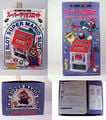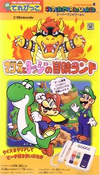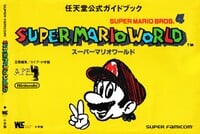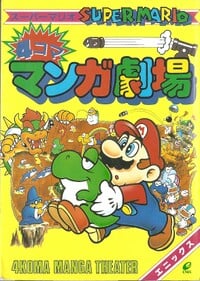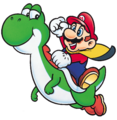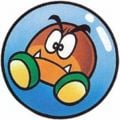Super Mario World
- Not to be confused with Super Mario Land, Super Mario 3D World, Super Nintendo World, or Super Mini Mario World.
- This article is about the SNES game. For other uses, see Super Mario World (disambiguation).
- "Super Mario Bros. 4" redirects here. For the Nelsonic Game Watch also known as "Super Mario Bros. 4", see Super Mario World (Nelsonic Game Watch).
- "SMW" redirects here. For the game known as "Super Mario Wii" in South Korea, see Super Mario Galaxy.
| Super Mario World | |||||||||||||||
|---|---|---|---|---|---|---|---|---|---|---|---|---|---|---|---|
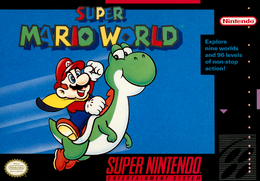 For alternate box art, see the related gallery. | |||||||||||||||
| Developer | Nintendo EAD | ||||||||||||||
| Publisher | Nintendo | ||||||||||||||
| Platforms | Super Famicom/Super Nintendo Entertainment System, Nintendo Super System, LodgeNet, Virtual Console (Wii, Wii U, New Nintendo 3DS), Super NES Classic Edition, Nintendo Classic Mini: Super Famicom, Super Nintendo Entertainment System - Nintendo Classics | ||||||||||||||
| Release dates | Super Famicom: Super Nintendo Entertainment System: Nintendo Super System: Virtual Console (Wii): Virtual Console (Wii U): Virtual Console (New 3DS): Super NES Classic Edition: Nintendo Classic Mini: Super Famicom: Super Nintendo Entertainment System - Nintendo Classics: Give the world a whole new look! | ||||||||||||||
| Languages | English Japanese | ||||||||||||||
| Genres | Platformer, action-adventure | ||||||||||||||
| Ratings |
| ||||||||||||||
| Modes | Single player, multiplayer | ||||||||||||||
| Format | Super Famicom:
SF Memory Cartridge:
Super NES: Wii: Wii U: Nintendo Switch: Nintendo 3DS: Super NES Classic Edition:
Built-in
| ||||||||||||||
| Input | Super NES: Wii: Wii U: Nintendo Switch: Nintendo 3DS: Super NES Classic Edition:
| ||||||||||||||
| Serial codes | |||||||||||||||
Super Mario World is a 2D action-adventure platform game developed by Nintendo EAD for the Super Famicom in 1990 and the Super Nintendo Entertainment System in 1991. It is a direct sequel to Super Mario Bros. 3 and the sixth entry in the Super Mario series. In Japan, it is recognized as the fifth.[15][16] This game was one of two launch titles for the Super Famicom, the other being F-Zero.[17] In being a sequel, Super Mario World retains many of the elements that debuted in Super Mario Bros. 3, such as the world map and Koopaling boss fights, while introducing a large variety of new gameplay mechanics, such as an expanded and less linear world map and the ability to save the game. Introduced in Super Mario World is Mario's sidekick, Yoshi (and his species that shares his name), who serves as a playable mount for the Mario Bros. with his own unique abilities and gameplay style. The overall game was meant to be modeled after an action movie franchise, as can be inferred by the Japanese version of the Koopaling defeat scenes as well as the summary on the back of the Japanese box.
The game was released to best-selling status on the SNES, received large amounts of critical acclaim, and is commonly seen on Nintendo's best games of all time on various critic listings. Many of its introduced characters, game mechanics, and artistic themes influenced later titles in the Super Mario franchise, and the character Yoshi was popular enough to receive a franchise starring him. The game was followed in 1995 by a prequel, Super Mario World 2: Yoshi's Island, set during Mario's infancy. Super Mario World has spawned various non-game media such as a cartoon series based on it, which debuted on September 14, 1991, one month after the American release. Various manga adaptions of the game have sprung up, one notable series being Super Mario-kun, which has its first volumes based on Super Mario World released in 1991 and is still ongoing today.
Super Mario World is included in the Super Mario All-Stars + Super Mario World compilation title released in December 1994. A reissue of Super Mario World was later released on the Game Boy Advance as part of the Super Mario Advance series, titled Super Mario World: Super Mario Advance 2. The original version was also rereleased on the Wii's Virtual Console in 2006, the Wii U's Virtual Console in 2013, and the New Nintendo 3DS's Virtual Console in 2016. Super Mario World is one of the included titles in the SNES Classic Edition and Super Nintendo Entertainment System - Nintendo Classics, the latter of which also includes a version titled Super Mario World: Give the world a whole new look!, which was initially released on March 30, 2022, and begins in Fall with 99 lives and a Cape Feather in the Item Stock.
Story[edit]
From the instruction booklet:
After saving the Mushroom Kingdom from Bowser and the rest of the Koopas in Super Mario 3, Mario and Luigi needed to recuperate from their adventures. Together they agreed that the best place to vacation was a magical place called Dinosaur Land.
But while Mario and Luigi reclined on the beach for a relaxing nap, Princess Toadstool disappeared, apparently seized by evil forces. After searching for hours for their missing friend, Mario and Luigi came upon an enormous egg in the forest.
Suddenly the egg hatched, and out popped a young dinosaur named YOSHI, who proceeded to tell Mario and Luigi a sad tale of how his dinosaur pals were sealed in similar eggs by a group of monstrous turtles.
"Monstrous turtles!,[sic]" exclaimed Luigi. "Bowser and his bunch have returned!" Mario slowly nodded his head in agreement and, along with Luigi and Yoshi, set off across Dinosaur Land to find the Princess and to free Yoshi's friends. As they began their journey, Yoshi handed Mario a beautiful cape. "This may help you," Yoshi said. "Some say it has magical powers."
With a little luck (and help from a magic cape), our hearty crew can defeat the seven worlds of Bowser's Krazy Koopa Kritters. Many locations are well-hidden so explore everywhere and try everything. Not all locations have to be explored to rescue the dinosaurs and save Princess Toadstool, but there are many "starry" treasures to be found in far-reaching places. You'll need to search all areas to find what kinds of treasures are there... in Super Mario World.
Super Mario World is the only sequel in the Super Mario series to take place directly after the events of a previous entry. After Bowser's previous defeat, Mario, Luigi, and Princess Toadstool decide to recuperate in Dinosaur Land. Meanwhile, in Dinosaur Land, Bowser and his Koopalings trap Yoshi and his friends in enchanted eggs, eliminating the opposition as they secretly rebuild their forces. Shortly upon their arrival, the Mario Bros. realize that Toadstool is missing. While searching, they find the Koopa Troop. Upon the Mario Bros. freeing the friendly Yoshi, he exclaims that the Koopas have invaded, confirming that Bowser has indeed returned and taken the opportunity to claim the princess.
As Mario and his friends travel through Dinosaur Land, they uncover the Valley of Bowser, where Bowser is fought on his castle roof in his Koopa Clown Car, holding Toadstool hostage. Upon his defeat, he gently drops the princess and retreats. Toadstool rewards Mario or Luigi with a kiss as fireworks celebrate freedom, signifying that their vacation can resume with their new good friends. The reunited team returns to Yoshi's House, where the team and three other Yoshis watch the eggs hatch into babies, removing the spell.
Gameplay[edit]
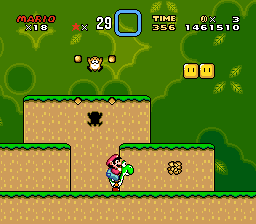
As the game is a 2D platformer, the object of every level is to get to the Giant Gate at the end to advance to the next level before the timer runs out. Mario (or Luigi) can jump over and on top of various platforms and obstacles and stomp on various enemies to defeat them. In addition to the basic jump, Mario can spin-jump to destroy certain types of blocks and enemies, whereas or
lets Mario dash if held down. When the player presses either of those buttons when Mario is next to some items, he can pick them up and carry them through the level as the buttons are held. Mario can now hold objects underwater; when he does, he can swim quickly when the player uses only
![]() without pressing the jump button. When Mario hits the Giant Gate at the end of the level, if he touches the vertically moving tape between the gate, he gets awarded Bonus Stars depending on how high the tape is when he touches it. If he collects 100 Bonus Stars, Mario can play a bonus game that helps him earn extra lives. Some levels contain a Midway Gate, which not only powers Mario up to Super Mario when touched but also serves as a checkpoint for Mario to respawn near if he gets defeated in the level.
without pressing the jump button. When Mario hits the Giant Gate at the end of the level, if he touches the vertically moving tape between the gate, he gets awarded Bonus Stars depending on how high the tape is when he touches it. If he collects 100 Bonus Stars, Mario can play a bonus game that helps him earn extra lives. Some levels contain a Midway Gate, which not only powers Mario up to Super Mario when touched but also serves as a checkpoint for Mario to respawn near if he gets defeated in the level.
Mario can transform with power-up items, mostly found in blocks. The basic Super Mushroom, which turns Mario into Super Mario, causes him to grow bigger and allows him to sustain an extra hit. When Super Mario hits a block, usually a more powerful item spawns in the Super Mushroom's place, such as a Fire Flower or the newly introduced Cape Feather. Introduced in Super Mario World is the Item Stock, where Mario can hold on to one extra item should he find it while in powered-up forms; players can manually drop their reserve item by pressing . If Mario gets damaged and turns into regular Mario, the reserve item automatically deploys. A newly introduced character and power-up in Super Mario World, Yoshi, also appears from certain blocks. Mario can jump on Yoshi to ride him and receive more special abilities, the most prominent one being using his tongue to eat enemies and carry items.
If Mario gets touched by an enemy or a damaging obstacle while he is in his small form, he loses a life. If he gets damaged by an enemy while in a power-up form, he reverts to his normal form. If Mario loses all of his lives, the player receives a Game Over and is prompted to continue from their last save with five more lives. Some obstacles defeat Mario instantly regardless of what power-up he has, such as falling into pits or lava, getting crushed, and not making it to the goal in time. Every time Mario gets defeated, he gets sent back to the world map.
Super Mario World retains the world map system from Super Mario Bros. 3 with more expanded features. Rather than having levels and worlds segmented, most worlds and levels are seamlessly connected to each other, with a heavier focus on multiple paths per level clearance, and thus creating a less linear map, with a few exceptions. Typically, prior to entering new areas, Mario has to defeat a castle boss, usually one of Bowser's seven children, the Koopalings. Once they are defeated, the castles they reside in are destroyed and cannot be replayed, though in international versions of the game, they can be replayed if players hold and
on the castles' remains.
Two-player mode returns, where players take turns playing through the game; Player 1 controls Mario, while Player 2 controls Luigi. Players can opt to use the same controller or two controllers to play the mode. If one player fails to clear a course, the other player takes a turn, and if a Midway Gate is touched, the other player starts at the Midway Gate. Players can also hand each other lives on the map screen if they press or
.
After the player beats every special level in the Special Zone, a game aesthetic change called Fall occurs, where the world map obtains a different palette and some enemies get their sprites changed. Once Fall is activated, these changes cannot be reversed unless the save file is deleted and a new game is started.
Controls[edit]
| Action(s) | SNES | Wii (Classic Controller) | Wii (GameCube Controller) | 3DS | Wii U | Switch (Dual Joy-Con / Pro Controller) | Switch (Single Joy-Con) |
|---|---|---|---|---|---|---|---|
| Move | |||||||
| Crouch | |||||||
| Look up | |||||||
| Spin Jump | |||||||
| Jump | |||||||
| Dash / Interact / Special ability | |||||||
| Screen Scroll Option[18] left (does not work in auto-scrolling levels, at Yoshi's House, in the Top Secret Area, or in Boss Rooms) | |||||||
| Screen Scroll Option right (does not work in auto-scrolling levels, at Yoshi's House, in the Top Secret Area, or in Boss Rooms) | |||||||
| Pause | |||||||
| Use item / Return to map from a completed level (when paused) |
Worlds and levels[edit]
Super Mario World takes place on the archipelago of Dinosaur Land, and players navigate it through a world map comprised of a greater, general view of the whole land and several sub-maps for specific areas. Unlike in Super Mario Bros. 3, whose world maps featured mostly numbered panels largely detached from the landscape, levels in Super Mario World are marked by button-like spots laid on the environment itself, creating an organic appearance between the world and each level. Players first start out on Yoshi's Island at Yoshi's House, where the path immediately branches off into two levels. The order of the world themes is unique to this title: Players first start in two grassy plain-like worlds while eventually venturing into a cave toward a sky area, into a forest, onto a rocky island, and finally into the Valley of Bowser, which takes on a subterranean wasteland. Haunted Ghost Houses are introduced in Super Mario World and populate Dinosaur Land; unlike traditional level layouts, they tend to contain puzzles and traps designed to confuse the player. Cave levels and levels that primarily take place underwater or where water is prevalent are additionally marked as such on the map, with most cave levels outside the Vanilla Dome and the Valley of Bowser featuring rocks around them, while Mario gets submerged in water for the water levels.
Super Mario World contains nine worlds and 73 (74 if the Back Door and Front Door are counted as separate levels, 76 if the Top Secret Area and Yoshi's House are counted as levels, 75 if Yoshi's House and the Top Secret Area are counted as levels and the Back Door and Front Door are counted as one level, and 72 if the Back Door, the Front Door, Yoshi's House, and the Top Secret Area are not counted as levels) levels in total. 24 of these levels have secret exits, so depending on how one counts the levels, this makes for a total of 96 to 100 exits, although only 96 are tracked by the game. Almost all worlds contain four regular levels and at least one secret level. Levels marked in yellow contain one exit, while levels marked in red contain an alternative, secret exit. Other points of interest include the Switch Palaces, Warp Pipes, and the star-shaped portals to Star World that are unlocked only when players find the associated secret exit. Switch Palaces activate respectively colored permeable Dotted Line Blocks and turn them into solid Exclamation Mark Blocks that can be stood on or hit from below. Once Switch Palace levels have been completed, they cannot be visited again. Warp Pipes warp players to different areas of the map, usually to different worlds altogether. Finally, Yoshis cannot be taken into castles, fortresses, or Ghost Houses, though Yoshi remains outside for the player if they exit the level. In castles, players have to defeat the Koopalings, while in fortresses, players need to defeat Reznors.
Star World and the Special Zone are bonus worlds that are accessed when players find secret exits throughout Dinosaur Land that lead to the Star Roads. The Star World levels require the player to find a key and keyhole secret exit to progress through it, while the Special Zone is a linear area that is unlocked when players complete all of Star World's secret exits. The Special Zone levels are much more difficult relative to the levels in this game; none of the levels contain Midway Gates, and some can be long while others use level gimmicks.
| World | Image | Information | |||
|---|---|---|---|---|---|
| World 1 Yoshi's Island |
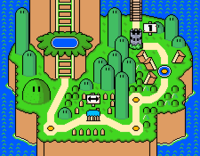
|
Yoshi's Island is mainly a grassy plains-related world that does not contain any underwater levels. The main enemies in this world include Monty Moles, Koopa Troopas, Rexes, and a few others. Iggy is found in his castle at the end of this world. Completing this world leads to Donut Plains. This world also contains the Yellow Switch Palace. This is the only world (along with the Special Zone) not to have any secret exits. | |||
| World 2 Donut Plains |
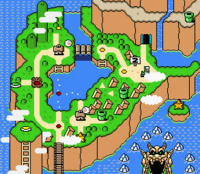
|
Donut Plains is the second world in the game. It is known for featuring the first Ghost House and for being the first to have a course with multiple exits. The Cape Feather is utilized frequently. The name of this world is a reference to its unique shape. It has two Ghost Houses, the Green Switch Palace, and Castle #2. | |||
| World 3 Vanilla Dome |
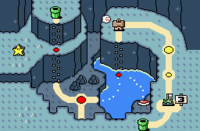
|
The Vanilla Dome is a big cavern full of sparkling diamonds and contains a Ghost House, a large lake, the Red Switch Palace, and Castle #3. It also contains lava pools with the large Blarggs living within them. | |||
| World 4 Twin Bridges |
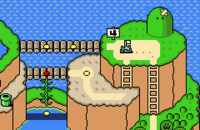
|
The Twin Bridges area is semi-sky-based, as it has sky and land levels. This world contains one underwater level and the third portal to Star World. | |||
| World 5 Forest of Illusion |
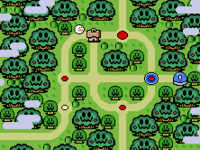
|
The Forest of Illusion is a maze-like forest, where Mario or Luigi may sometimes have to find the secret exit in a level in order to progress, as the normal exits create a circle leading nowhere. This world contains the Blue Switch Palace, a fortress, and Castle #5. | |||
| World 6 Chocolate Island |
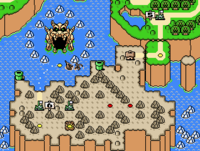
|
Chocolate Island is an island on the southeastern side of Dinosaur Land. The boss here is Wendy. This is the only world where Mario and Luigi can find Dino-Rhinos and Dino-Torches. | |||
| World 7 Valley of Bowser |
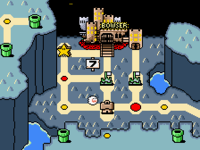
|
The Valley of Bowser is, as the name implies, Bowser's base of operations. The entrance to the Valley of Bowser appears after the player passes through the Sunken Ghost Ship. This world is mostly cave-themed and contains a fortress, Castle #7, and Bowser's Castle. | |||
| World 8 Star World |
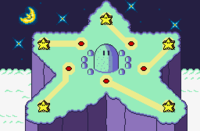
|
Star World is a mystical road far above the Mushroom World, and it is linked to various locations around the world. It consists of five stars, each of which serves as a warp point. | |||
| World 9 Special Zone |
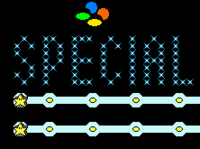
|
The Special Zone is the final and most secret world. It can be accessed after the player completes Star World and takes the secret exit from Star World 5. This world is known for containing the most difficult levels in the game, and each level has its own unique gimmick. | |||
Level features[edit]
| Image | Name | Description |
|---|---|---|
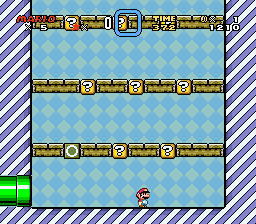
|
1-Up Chamber | A bonus area accessed through pipes in some levels. This minigame lets players win up to five 1-Up Mushrooms by hitting Prize Blocks in a correct order. |
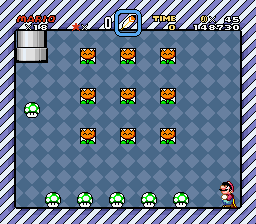
|
Bonus game | At the ends of levels that are not castles or fortresses, if players receive 100 Bonus Stars at the Giant Gates, they play a minigame that gives them the opportunity to earn bonus lives. |
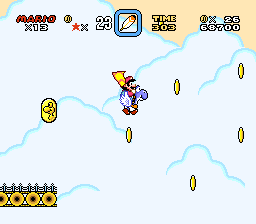
|
Coin Heaven | A bonus, sky-themed area accessed by using pipes, Beanstalks, and Yoshi's Wings, where players are typically awarded many coins. Unlike in other areas of the level, if the player falls, they do not lose a life and resume the main level. The variant that requires Yoshi's Wings auto-scrolls and contains five Dragon Coins; if players drop down, they finish the level. |
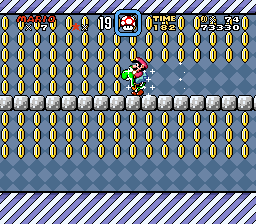
|
Switch Palace | A bonus level that contains a Switch that turns the respectively colored Dotted Line Blocks into solid Exclamation Mark Blocks. Once completed, Switch Palaces cannot be accessed again. There are four Switch Palaces in the game, and all except the Yellow Switch Palace require players to take secret exits to access them. |
Characters[edit]
Playable characters[edit]
Mario and Luigi are the main playable characters. In two-player mode, Mario is controlled by Player 1 and Luigi is controlled by Player 2. If Mario loses a life or completes a level in two-player mode, Luigi comes into play until he does the same. The two may also share extra lives on the world map. The two have identical mechanics.
Non-playable characters[edit]
| Image | Name | Description |
|---|---|---|
| Princess Toadstool | The princess of the Mushroom Kingdom, who is kidnapped by Bowser during the vacation. The main objective of the game is to rescue her from Bowser. | |
| Dolphins | Sea creatures that give Mario a ride in certain water levels. Dolphins move in jumping arcs or can jump up and down. In Japanese versions of the game, they can be eaten by a Yoshi, while they cannot be eaten in international versions. Dolphins appear in Vanilla Secret 3 and a small section at the end of Chocolate Island 1. |
Yoshis[edit]
In addition to Mario and Luigi, Yoshis of four different colors appear in the game, and they can be controlled once acquired and help the Mario Bros. in many levels of the game. Green Yoshis hatch out of eggs, usually found in various blocks throughout the game. If an egg is found but the player already has a Yoshi, the egg instead provides a 1-Up Mushroom. If a Yoshi gets hurt, it runs off, requiring the Mario Bros. to chase it down if they want to ride it again. A Yoshi can additionally provide a Yoshi Boost[19] (or Double Jump)[20] to Mario if he jumps off the Yoshi. Some levels contain berries, and Yoshis can eat them and produce eggs from them if enough are eaten. Yoshis can eat most enemies, though they cannot immediately swallow most shells, requiring them to spit the shells out before they eventually swallow them.
Red, Blue, and Yellow Yoshis are uncommon in Super Mario World. They are first encountered in Star World, which is accessible by using the five Star Roads found throughout the game. Red, Blue, and Yellow Yoshis are found as Mini-Yoshis, small and unable to be ridden. However, through carrying them, the Mini-Yoshis eat the enemies and items they touch. When they eat five enemies, shells, coins, or active Grab Blocks, they transform into adult Yoshis and can be used normally. If a Mini-Yoshi eats a single power-up, it grows up instantly. Mini-Yoshis of all colors hatch from the eggs rescued from the castles during the end credits of the game.
| Image | Name | Description |
|---|---|---|
| Yoshi | Yoshi is Mario's sidekick who requests for Mario's assistance. After he is freed from his egg, he can give rides for Mario and eat intrusive enemies. Green Yoshis are able to eat enemies by using their long tongues and jump on spiked foes without taking harm as well as walk across Munchers. Green Yoshis can use a Koopa Shell's power depending on the color of the shell. | |
| Mini-Yoshis | If Mario passes nearby a lone egg, it hatches into a Mini-Yoshi. The player must feed the Mini-Yoshi five enemies, shells, coins, or active Grab Blocks for it to grow into an adult Yoshi. Feeding the Mini-Yoshi a single power-up causes it to grow up instantly. Every time a Mini-Yoshi eats something other than a power-up, the player receives a coin and 200 points. | |
| Red Yoshi | Red Yoshis can spit out any Koopa Shell in the form of three fireballs. These fireballs turn a variety of enemies into coins. Red Yoshis are found as Mini-Yoshis in Star World 1 and Star World 4. | |
| Blue Yoshi | Blue Yoshis can fly regardless of what color the Koopa Shell is in their mouths. Additionally, Yoshi can become a Blue Yoshi if he touches Yoshi's Wings, which appear in some levels and act as shortcuts to the end of the stage. Blue Yoshis are found as Mini-Yoshis in Star World 2. | |
| Yellow Yoshi | Yellow Yoshis can create small sand clouds when they hit the ground while they carry a Koopa Shell in their mouths, defeating enemies within the range of the cloud. They are found as Mini-Yoshis in Star World 3 and Star World 5. |
Enemies and obstacles[edit]
Enemies[edit]
Super Mario World retains some of the enemies from Super Mario Bros. 3, such as the common Koopa Troopas and their varieties, Ghost House-dwelling Boos, Buzzy Beetles in a cave environment, and Cheep Cheeps underwater, while introducing more species that would regularly appear in later entries in the Super Mario series, such as Magikoopas, Fishbones, Swoopers, and Wigglers. Goombas are featured less prominently in this title and function differently than in prior Super Mario titles; they are later localized as Galoombas. Some of the new enemies introduced are variants of other species, such as the cape-wielding and flying Super Koopas, the large Banzai Bills that are encountered before regular Bullet Bills, the spike-donning Spike Tops, and the pipe-inhabiting Lakitus. Included with the introduced enemies are various new obstacles, most of which populate the castle and fortress levels in the game, and several of these obstacles would make later appearances in the Super Mario series, namely Grinders and Skewers. When Fall is unlocked, some of these enemies have their graphics changed and their names in the staff roll replaced. However, their behaviors are unaltered.
The enemies listed in this table match those in the Super Mario Bros. Encyclopedia[21] and the Mario Portal Game Archive.[22] The default order they are listed in derives from Nintendo Kōshiki Guidebook Super Mario World[23] with adjustments that ensure enemies are listed next to their immediate relatives. The different-colored variants of unshelled Koopas and Super Koopas are not distinguished in any of these sources, but they are listed separately here because they have unique behaviors like the normal shelled Koopas. Ball 'N' Chains are recognized in-game and in the guidebook as enemies, but they are considered obstacles in the encyclopedia, and this is followed suit here. Mario Mania, a guidebook that recognizes a different subset of enemies, is not the basis for the subjects of this table.[24]
| Image | Name | Description | Levels | New | |
|---|---|---|---|---|---|
| First | Last | ||||
| Goomba | A round, chestnut-like creature. After stomping a Goomba, Mario can carry it for a short distance and throw it. Some Goombas come floating in bubbles. | Donut Plains 4 | Funky | ||
| Para-Goomba | A parachuting Goomba. | Donut Plains 4 | Chocolate Island 5 | ||
| Flying Goomba | A hopping winged Goomba. | Donut Plains 4 | Funky | ||
| Spiny | A spiked turtle that cannot be jumped on. Spinies are born from Spiny Eggs, which are thrown by Lakitus. | Vanilla Secret 2 | Gnarly | — | |
| Spiny Egg | A Lakitu throws this. When it hits the ground, it hatches into a Spiny. | Vanilla Secret 2 | Gnarly | — | |
| Bob-omb | A walking bomb with a short fuse. Bob-ombs are portable once Mario stomps them. They also appear in bubbles. | Vanilla Secret 2 | Chocolate Island 5 | — | |
| Para-bomb | A parachuting Bob-omb. | Vanilla Secret 2 | Chocolate Island 5 | ||
| Fuzzy | A black furball that follows a set path. It cannot be stomped on, but it can be bounced off with a Spin Jump. | Donut Plains 3 | Way Cool | ||
| Wiggler | A yellow caterpillar. When Mario jumps on its head, it turns red and moves faster. It is impervious to fireballs. | Forest of Illusion 1 | Outrageous | ||
| Jumping Piranha Plant | A carnivorous plant that jumps out of a pipe. It cannot be stomped on, but it can be bounced off with a Spin Jump. In Fall, all Piranha Plant variants wear jack-o'-lanterns on their heads. These ones are called Jumping Pumpkin Plants. | Yoshi's Island 1 | Groovy | ||
| Jumping Fire Piranha Plant | This rare Jumping Piranha Plant spits fireballs. | Cookie Mountain | Funky | ||
| Piranha Plant | A carnivorous plant that lives in a pipe. It cannot be stomped on, but it can be bounced off with a Spin Jump. It can be defeated with fireballs, capes, or Yoshi. | Vanilla Dome 3 | — | ||
| Volcano Lotus | A fire-spitting lotus plant. It cannot be jumped on, though fireballs, capes, or Yoshi can defeat it. | Donut Plains 1 | Groovy | ||
| Chargin' Chuck |
A turtle dressed in football gear who charges at Mario. Most Chargin' Chucks are Lookout Chucks that charge directly at Mario once they appear onscreen, and they can jump up vertical walls. Others have unique means of attack, but they revert to Lookout Chucks when stomped. These are the uniquely behaving Chucks: Clappin' Chucks that jump straight up and clap when approached, Splittin' Chucks that split into three, Passin' Chucks that have endless supplies of gridiron footballs to kick, Confused Chucks that throw baseballs, Diggin' Chucks that dig up rocks with a shovel to throw at Mario, ones that jump high into the air, and ones that whistle to summon other enemies such as Rip Van Fish and Super Koopas. |
Yoshi's Island 1 | Funky | ||
| Sumo Brother | A big Koopa that stomps the ground and sets fire to everything below him. | Cookie Mountain | Funky | ||
| Pokey | A mobile cactus with a spiked head. If Mario is riding Yoshi, a Pokey will have five sections instead of three. It cannot be stomped on, but it can be bounced off with a Spin Jump. | Yoshi's Island 4 | Groovy | — | |
| Monty Mole | A mole that pops out of mountains and the ground and gives chase. | Yoshi's Island 2 | Cookie Mountain | ||
| Mega Mole | A giant Monty Mole that lives underground. It can be ridden on. | Chocolate Island 4 | Valley of Bowser 2 | ||
| Rex | A blue dinosaur that takes two stomps to defeat. After the first stomp, the Rex is squished to half its size and becomes faster. A second stomp flattens it completely and defeats it. | Yoshi's Island 1 | Awesome | ||
| Dino-Rhino | A slow-moving ceratopsian dinosaur. When jumped on, it turns into a Dino-Torch. | Chocolate Island 1 | Chocolate Island 2 | ||
| Dino-Torch | A tiny Dino-Rhino that breathes fire. | Chocolate Island 1 | Chocolate Island 2 | ||
| Koopa (Red) | A turtle that paces steadily back and forth on a platform. When it reaches an edge, it turns around. In Fall, all Koopas wear Mario Bros. masks and are referred to as Mask Koopas. | Yoshi's Island 2 | Funky | — | |
| Koopa (Green) | A turtle that walks off edges. | Yoshi's Island 3 | Funky | — | |
| Koopa (Blue) | This turtle is faster than other Koopa Troopas. It walks back and forth on its platform. | Donut Plains 3 | Funky | ||
| Koopa (Yellow) | This turtle walks towards Mario and drops a coin if stomped. | #3 Lemmy's Castle | Funky | ||
| Unshelled Koopa (Red) | A shell-less Koopa Troopa that avoids edges. It becomes a red Koopa Troopa after entering a shell. | Yoshi's Island 2 | Funky | ||
| Unshelled Koopa (Green) | A shell-less turtle that walks off edges. It becomes a green Koopa Troopa after entering a shell. | Yoshi's Island 2 | Funky | ||
| Unshelled Koopa (Blue) | This is the slowest shell-less turtle. Unlike the other three colors, blue unshelled Koopas do not enter a shell. They slide on slopes and will kick a shell if they come in contact with one. | Yoshi's Island 1 | Funky | ||
| Unshelled Koopa (Yellow) | Once it jumps into a Yellow Shell, it becomes a flashing Shell. | Donut Plains 4 | Funky | ||
| Super Koopa (Red) | A flying unshelled Koopa. It swoops down when Mario approaches, then rises back up. | Donut Plains 1 | Butter Bridge 2 | ||
| Super Koopa (Green) | It swoops down when Mario approaches, then rises back up. Green Super Koopas can be generated by whistling Chargin' Chucks. | Butter Bridge 2 | Funky | ||
| Super Koopa (Blue) | It starts on the ground and takes off, flying forward. Some blue Super Koopas have flashing capes and drop a Cape Feather when stomped. | Donut Plains 1 | Butter Bridge 2 | ||
| Koopa Paratroopa (Green) | A green Koopa Troopa with wings. It jumps around aimlessly. | Yoshi's Island 3 | Funky | — | |
| Koopa Paratroopa (Red) | A red Koopa Troopa with wings. It flies around in a set area. | Donut Secret 2 | Awesome | — | |
| Koopa Paratroopa (Yellow) | A yellow Koopa Troopa with wings. It never flies, but it hops over shells that are kicked at it. | Awesome | Funky | ||
| Climbing Koopa (Green) | This variety of Climbing Koopa moves slowly. | #1 Iggy's Castle | #4 Ludwig's Castle | ||
| Climbing Koopa (Red) | This variety of Climbing Koopa is as fast as Mario and Luigi. | #1 Iggy's Castle | Bowser's Castle | ||
| Muncher | An invincible black plant. | Donut Secret 2 | Mondo | — | |
| Fishin' Lakitu | A Lakitu fishing with a 1-Up Mushroom. If Mario takes the bait, the enemy turns into a normal Lakitu. | Forest of Illusion 4 | |||
| Lakitu | A turtle that rides in a cloud and throws Spiny Eggs down at Mario. If Mario hits him with a throwable object or spinning cape, he can ride in his cloud for a limited time. However, if a Lakitu is stomped on, the cloud disappears. In some courses, Lakitus occur in pipes. | Vanilla Secret 2 | Gnarly | — | |
| Amazing Flyin' Hammer Brother | This enemy tosses hammers from its swooping platform, attempting to attack Mario. It can be defeated by hitting the bottom of the platform it sits on. | Donut Plains 4 | Outrageous | ||
| Bullet Bill | A slow-moving bullet. It is impervious to fireballs. In Fall, Bullet Bills are replaced with Pidgit Bills. | Vanilla Dome 4 | Outrageous | — | |

|
Banzai Bill | A giant slow-moving bullet. The cannons Banzai Bills are fired from are not seen anywhere in the game. | Yoshi's Island 1 | Awesome | |
| Torpedo Ted | A slow-moving torpedo. | Soda Lake | |||
| Spike Top | A single-spiked red turtle that climbs around walls and platforms. Just like Buzzy Beetles, Spike Tops are immune to fireballs. They cannot be stomped on, but they can be bounced off with a Spin Jump. | Donut Plains 2 | Valley of Bowser 4 | ||
| Buzzy Beetle | A small turtle that behaves just like a green Koopa Troopa, except fireballs have no effect on it and it never leaves its shell. | Donut Plains 2 | Chocolate Secret | — | |
| Swooper | A green bat that lives in a cave and swoops downwards. | Donut Plains 2 | Valley of Bowser 2 | ||
| Blargg | A lava dinosaur. Only its eyes are visible before it dips back into the lava and lunges at Mario. It cannot be stomped on, but it can be bounced off with a Spin Jump. | Vanilla Dome 1 | Chocolate Secret | ||
| Cheep Cheep | A small fish that slowly swims back and forth. Cheep Cheeps also are found in bubbles; once popped from them, they flop across the level. | Yoshi's Island 4 | Mondo | — | |
| Blurp | A fish wearing goggles. It swims in only one direction. | Donut Secret 1 | Star World 2 | ||
| Porcu-Puffer | A fat spiny fish that swims in the water. It cannot be stomped on, but it can be bounced off with a Spin Jump. | Vanilla Secret 3 | Chocolate Island 1 | ||
| Urchin | A spiked creature that follows a set path underwater. | Forest of Illusion 2 | |||
| Rip Van Fish | A sleeping fish that will chase after Mario if it is awakened. | Donut Secret 1 | Star World 2 | ||
| Boo Buddy | A shy ghost that stops moving when Mario looks at it. It is impervious to fireballs and capes. It cannot be stomped on, but it can be bounced off with a Spin Jump. Some Boo Buddies appear as an invincible snake-like chain that bounce around the room. Others appear in large groups with members phasing transitioning from translucent and harmless, to opaque and damaging. Boo Buddies with a similar behavior appear in the Sunken Ghost Ship. Boo Buddies can also fly in a circle formation. They are impervious to nearly all attacks. | Donut Ghost House | Valley Ghost House | — | |
| Boo Buddy Block | A shy ghost that turns into a block when Mario looks at it. While in Boo form, it cannot be stomped on, but it can be bounced off with a Spin Jump. | Choco-Ghost House | |||

|
Big Boo | A giant Boo Buddy. It cannot be stomped on, but it can be bounced off with a Spin Jump. | Donut Secret House | Forest Ghost House | |
| Fishin' Boo | A Lakitu-like ghost in a cloud, fishing with a blue flame. | Choco-Ghost House | |||
| Eerie | A dinosaur-like ghost that floats in zigzag patterns. Eeries are impervious to most attacks. | Vanilla Ghost House | Valley Ghost House | ||
| Lava Bubble | An invincible ball of lava found in castles. It cannot be stomped on, but it can be bounced off with a Spin Jump. The diagonal type is always in the air, bouncing off any walls it runs into in an attempt to hurt Mario. | #1 Iggy's Castle | Bowser's Castle | — | |
| Ninji | An impish ninja enemy that jumps up and down. | Bowser's Castle | — | ||
| Dry Bones | A Koopa Troopa skeleton. It falls apart when Mario stomps on it, and after a short time, it reforms its body. It can also throw bones at Mario. It is impervious to fireballs. | #2 Morton's Castle | Bowser's Castle | — | |
| Bony Beetle | An undead Buzzy Beetle that periodically ducks and bears spikes. | Vanilla Fortress | Valley Fortress | ||
| Fishbone | A darting fish skeleton. It is impervious to fireballs. | Vanilla Fortress | Bowser's Castle | ||
| Lil Sparky | A little spark that circles a platform. | #6 Wendy's Castle | Bowser's Castle | ||
| Hothead | A giant spark that slowly circles a platform. It cannot be stomped on, but it can be bounced off with a Spin Jump. | #6 Wendy's Castle | Bowser's Castle | ||
| Thwomp | A large stone that drops as Mario approaches. It cannot be stomped on, but it can be bounced off with a Spin Jump. | #2 Morton's Castle | Bowser's Castle | — | |
| Thwimp | A tiny stone that hops around. It cannot be stomped on, but it can be bounced off with a Spin Jump. | #2 Morton's Castle | #7 Larry's Castle | ||
| Grinder | A spinning saw blade. It cannot be stomped on, but it can be bounced off with a Spin Jump. | Forest Fortress | #6 Wendy's Castle | ||
| Magikoopa | A Koopa sorcerer in a blue robe. It changes Rotating Blocks into various enemies and items and teleports. | #3 Lemmy's Castle | #7 Larry's Castle | ||
| Mechakoopa | A mechanical version of Bowser. After stomping it, Mario can pick it up and use it as a weapon. | Bowser's Castle | |||
Obstacles[edit]
| Image | Name | Description | Levels | |
|---|---|---|---|---|
| First | Last | |||

|
Ball 'N' Chain | A large spiked ball on a chain that cannot be defeated. The chain is harmless; it swings behind Mario. A Ball 'N' Chain cannot be stomped on, but it can be bounced off with a Spin Jump. | #2 Morton's Castle | Bowser's Castle |

|
Big Bubble | A slow-moving green bubble. It cannot be stomped on, but it can be bounced off with a Spin Jump. | Vanilla Ghost House | Valley Ghost House |
| Big Steely | A giant metal ball thrown by Bowser. It cannot be stomped on, but it can be bounced off with a Spin Jump. | Bowser's Castle | ||
| Chainsaw | An invincible saw blade that follows a designated path. It cannot be stomped on, but it can be bounced off with a Spin Jump and with Yoshi. | Cheese Bridge Area | Way Cool | |
| Decoy | This harmful impostor pops out of pipes used by Lemmy and Wendy. Decoys always come in pairs and can be stomped on. | #3 Lemmy's Castle | #6 Wendy's Castle | |
| Falling spike | A spiked obstacle that falls from the ceiling. | Vanilla Fortress | Valley Fortress | |
| Fire Snake | A jumping ball of fire that leaves fire behind as it jumps. It cannot be stomped on, but it can be bounced off with a Spin Jump. | Outrageous | ||
| Flame | Fire dropped by Bowser. It cannot be stomped on, but it can be bounced off with a Spin Jump. | Bowser's Castle | ||
| Floating Mine | A floating spiked mine. It cannot be stomped on, but it can be bounced off with a Spin Jump. | Yoshi's Island 4 | Sunken Ghost Ship | |
| Gold Bowser Statue | A small statue of Bowser. The gold ones hop around. | #5 Roy's Castle | Bowser's Castle | |
| Gray Bowser Statue | A small statue of Bowser. The Gray Bowser Statues spit fire. | #5 Roy's Castle | Bowser's Castle | |
| Haunted Hole | A gap in the platform that moves left and right. | Choco-Ghost House | ||
| Lava | Molten rock that instantly causes Mario to lose a life. A chocolate version of lava appears in the Chocolate Fortress and Chocolate Island 4. | #1 Iggy's Castle | Bowser's Castle | |

|
Pillar | This obstacle moves slowly for some seconds, revealing itself, before suddenly smashing almost anything on its way. After some seconds later, it moves slowly back. | #1 Iggy's Castle | Bowser's Castle |
| Shifting wall | Shifting walls can crush Mario in certain areas, causing him to lose a life. | #2 Morton's Castle | Bowser's Castle | |
| Skewer | This obstacle moves up and down, blocking the path. | #6 Wendy's Castle | Bowser's Castle | |
| Spike | This obstacle comes down from the ceiling or up from the floor. Most spikes do not retract all the way, leaving their points exposed. | Chocolate Fortress | #7 Larry's Castle | |
| Spikes | Pointy obstacles that damage Mario. In #4 Ludwig's Castle, the falling ceiling is lined with spikes. Striking the nearby ON/OFF Switch forces the ceiling to recede. | #1 Iggy's Castle | Bowser's Castle | |
| Torpedo tube | This obstacle fires Torpedo Teds that are invincible to all available forms of attack. | Soda Lake | ||
| Turtle Cannon | An indestructible cannon. It shoots an endless number of Bullet Bills; however, it does nothing if the player is near it. | Sunken Ghost Ship | Outrageous | |
Bosses[edit]
| Image | Name | Description | Levels | |
|---|---|---|---|---|
| First | Last | |||
| Reznor | A fire-spitting Triceratops that comes in a set of four. Reznors guard the exits of all fortresses. | Vanilla Fortress | Valley Fortress | |

|
The Big Boo | He moves around the room while invisible, then suddenly reappears. | Donut Secret House | |
| Iggy Koopa | He tries to push Mario into a pool of lava while throwing magic balls. | #1 Iggy's Castle | ||
| Morton Koopa Jr. | He runs up the walls of his room, trying to drop onto Mario. | #2 Morton's Castle | ||
| Lemmy Koopa | He pops randomly out of seven pipes along with two decoys of himself. | #3 Lemmy's Castle | ||
| Ludwig von Koopa | He spins in his shell around the room, stopping to shoot fireballs. | #4 Ludwig's Castle | ||
| Roy Koopa | Like Morton, he runs up the walls of his room, trying to drop onto Mario. | #5 Roy's Castle | ||
| Wendy O. Koopa | Like Lemmy, she pops randomly out of seven pipes along with two decoys of herself. | #6 Wendy's Castle | ||
| Larry Koopa | Like Iggy, he tries to push Mario into a pool of lava while throwing magic balls. | #7 Larry's Castle | ||

|
Bowser | The final boss. He hovers above in his Koopa Clown Car, dropping Mechakoopas, Big Steelies, and Flames. | Bowser's Castle | |
Items and objects[edit]
Items[edit]
These are collectibles, pickups, and health-restoring objects.
| Image | Name | Description |
|---|---|---|
| Coins | When Mario collects 100 coins, he gets a 1-Up. When hit from certain Prize Blocks, Control Coins emerge that the player can control the direction of with | |
| Gray Coins | Pressing a Gray P Switch turns basic enemies into Gray Coins for a limited time. If enough are collected, they create extra lives. | |
| Dragon Coins | If Mario collects all five Dragon Coins or more on one stage, he gets a 1-Up. 1000 points are awarded, then double for each one collected. | |
| Bonus Coins | If Mario collects all ten Bonus Coins thrown by the Yoshi Cloud, it throws a 1-Up Mushroom. | |
| 1-Up Mushrooms | If Mario collects one of these, he gets an extra life. These mushrooms may also come from eggs if Mario is already riding Yoshi as either brother finds them from a block/passes them by. | |
| 3-Up Moons | If Mario collects one of these very rare items, he gets three extra lives. | |
| Keys | If Mario grabs a key and puts it in a keyhole (which is hidden in a level), a secret level is unlocked. | |
| Eggs | The eggs knocked out of Prize Blocks hatch into Yoshis. When a ridden Yoshi lays an egg, another item comes out. | |
| Red Berries | Eating ten Red Berries in one stage causes Yoshi to lay an egg with a Super Mushroom. A berry is also worth the same as a coin. | |
| Pink Berries | Eating two Pink Berries produces a Yoshi Cloud. | |
| Green Berries | Eating a Green Berry adds 20 seconds to the time limit. | |
| Jumping Boards | Jumping on these allows Mario to jump much higher than normal. | |
| Switch Blocks | When a blue Switch Block is pressed, blocks transform into coins and vice versa. After a short period of time, they revert back to normal. | |
| Gray P Switches | If a Gray P Switch is pressed, most basic enemies, such as Spinies, transform into Gray Coins. After a short period of time, they revert to normal. | |
| Grab Blocks | Dark-blue blocks that can be picked up and carried. Once grabbed, they can be kicked away to defeat enemies. | |
| Magic ball | An item that ends the current stage when touched. It appears only in the Sunken Ghost Ship. |
Power-ups[edit]
There is a total of six power-ups that provide transformations in the game, with one being exclusive to Yoshi. Most power-ups emerge from the blocks populated in levels, and players are able to carry an extra item in their Item Stock if they are already powered up. While the Super Mushroom, Fire Flower, and Super Star return, Super Mario World introduces the Cape Feather, which gently floats down when it appears onscreen as well as being able to be spawned from defeating a Super Koopa with a flashing cape. The new Power Balloon is a rare item used in a few levels and serves as a temporary transformation for Mario and Luigi.
In addition to the power-up items, Mario and Luigi can encounter other level features that help them progress through the level, such as 1-Up Mushrooms granting them extra lives or keys and keyholes granting them access to secret levels.
Forms that share a column look the same for both Mario and Luigi.
| Power-up | Form | Description | |
|---|---|---|---|
| N/A | Small Mario |
Small Luigi |
Small Mario is default and the weakest form Mario starts with. If he touches an enemy from damaging areas, such as their sides, as well as damaging obstacles, he loses a life. |
Super Mushroom |
Super Mario |
Super Luigi |
Super Mushrooms turn Mario into Super Mario. He can sustain a hit from most obstacles and reverts to Small Mario if he gets hit. When Super Mario hits blocks, they spawn with more powerful items, such as Fire Flowers or Cape Feathers. 1,000 points are awarded. |
Fire Flower |
Fire Mario |
Fire Luigi |
Fire Flowers turn Mario into Fire Mario, enabling him to launch small fireballs that defeat enemies and give out coins when defeated. 1,000 points are awarded. |
Cape Feather |
Caped Mario |
Caped Luigi |
Cape Feathers turn Mario into Caped Mario. He can spin his cape to defeat enemies as well as slow his descent while the jump button is held down. Caped Mario can fly if he is given a running start. 1,000 points are awarded. |
Power Balloon |
Balloon Mario |
Balloon Luigi |
Power Balloons turn Mario into Balloon Mario. He can float for a limited time, and extra Power Balloons replenish the time spent in the air. No points are awarded upon him collecting the item. |
Super Star |
Invincible Mario / Luigi |
Super Stars make Mario become Invincible Mario temporarily, allowing Mario to defeat most enemies by running into them. If the player collects more Super Stars in blocks while invincible, the duration of the invincibility is extended. 1,000 points are awarded. Enemies defeated while the player is invincible count towards points eventually becoming 1-Ups or 2-Ups, depending on the enemy. | |
Yoshi's Wings |
Winged Yoshi |
Yoshi's Wings grant Yoshi the ability to fly and enter Coin Heaven. They turn any Yoshi blue after completion, making this the only way to get a Blue Yoshi outside Star World. | |
Objects[edit]
These are interactable elements of the environment that cannot be picked up or collected.
| Image | Name | Description |
|---|---|---|
| Blocks and containers | ||
| Bonus Block | A block that gives out a 1-Up Mushroom if the player has 30 coins. If the player has fewer than 30 coins, the block gives out one coin. | |
| Brown Block | A Prize Block that no longer has an item in it. Some Brown Blocks form snakes that carry players through the level. | |
| Bubble | Bubbles float around and can contain Super Mushrooms, Goombas, Bob-ombs, or Cheep Cheeps. | |
| Cloud Block | Cloud Blocks form long stretches of terrain high in the sky. These blocks are usually reached through Beanstalks and lead to rare items. | |
| Dotted Line Block | A permeable block that indicates the presence of an Exclamation Mark Block. Dotted Line Blocks turn solid once the ! Switch of the corresponding Switch Palace is activated. | |
| Exclamation Mark Block | A block that starts out as a Dotted Line Block prior to the player hitting the ! Switch at the block's corresponding Switch Palace. After the ! Switch is activated, Exclamation Mark Blocks turn solid, behaving as platforms or as Prize Blocks. Yellow and green Exclamation Mark Blocks contain a Super Mushroom and a Cape Feather, respectively. | |
| Flying Prize Block | A Prize Block with wings that moves about. Once hit, it turns into a static Brown Block. | |
| Gray Block | An unbreakable block. Some Gray Blocks are stacked or laid next to each other to form greater platform structures. | |
| Ice Block | A frozen version of Rotating Block that acts as a slippery platform. | |
| Jump Block | A block that causes the players to automatically jump. When the jumping is timed right, players can jump even higher, acting similarly to a Jumping Board. Some Jump Blocks contain power-ups within them, and they can be activated by hitting them as normal blocks or by touching them. | |
| Message Block | A block that gives out Points of Advice, which are designed to help players learn the game. | |
| O/X Block[25] | A Prize Block found in 1-Up Chambers. Striking the Prize Blocks in the correct order awards Mario as many as five 1-Up Mushrooms. | |
| ON/OFF Switch | A block that can change the path a Pulley Lift travels on or can toggle the direction of a falling ceiling in #4 Ludwig's Castle. | |
| Prize Block | Gives a variety of items when hit, such as coins, power-ups, and other items. Once depleted, it turns into a Brown Block. Some Prize Blocks are Coin Blocks that contain a total of 10 coins. Some Prize Blocks are hidden and are revealed either if the player hits them or if they are activated by a Switch Block. | |
| Red ? Block | A block that activates a floating spotlight found near the end of Bowser's Castle. | |
| Rotating Block | A block that flips when it is hit from below or by Caped Mario, making it impossible to land on. Super Mario can destroy Rotating Blocks by spin-jumping on them. Chargin' Chucks can destroy them, and some enemies are hidden in them. | |
| Roulette Block | A block that contains power-ups that swap between the available types. Items that are released from the blocks still change form when they are out. | |

|
Stretch Block | A platform composed of five blocks that stretch or compress in a set pattern, either vertically or horizontally, sometimes alternating between the two. |
| Triangular Block | A block that allows Mario to run up walls. Yoshi cannot run up walls, though he can bounce off Triangular Blocks. | |
| Yoshi Cloud | A cloud that hatches from an egg after Yoshi eats two Pink Berries. If Mario catches all 10 Bonus Coins that it drops, it will release a 1-Up Mushroom. | |
| Climbable objects | ||
| Beanstalk | Found hidden in blocks, Beanstalks grow out of blocks and give players access to upper parts of a level, including new areas that can lead to secret exits. Players cannot climb them while riding on Yoshi. | |
| Fence | Located in a variety of castle or fortress levels, fences can be climbed on by players. Players can also hit a fence to activate Revolving Doors or defeat Climbing Koopas on the other side. | |
| Revolving Door | A panel embedded in a fence. Striking one causes it to rotate and brings Mario to the other side of the fence. | |
| Rope | An object players can climb on, similar to a Beanstalk and a fence. Ropes are used to travel through a level. Players cannot climb them while riding on Yoshi. | |
| Doorways and transportation objects | ||
| Blue Door | A door that is visible only if a Switch Block is active. | |
| Keyhole | Keyholes are secret exits. Bringing a key to a keyhole makes it rapidly expand and engulf Mario, making him exit the level, and causes a new route to appear on the map. | |
| Lakitu's Cloud | If a Lakitu is defeated without being stomped on, his cloud can be ridden for a short time until it disintegrates. | |
| Pipe Cannon | A diagonal-facing Warp Pipe that shoots Mario out of it. Pipe Cannons are exit points, usually from an underground area. | |
| Warp Pipe | A pipe that can lead players to another area of the level if they either duck or jump into one. Some Warp Pipes contain varieties of Piranha Plants or Lakitus, some extend and retract (found only in Donut Plains 4, Forest of Illusion 4, and Chocolate Island 5), and some large, diagonal Warp Pipes launch players. | |
| Yellow Door | A door found in Ghost Houses, fortresses, and castles. Yellow Doors take the player to another portion of the level. Large red doors serve as entry points to a boss. | |
| Platforms | ||
| Bouncing bough | A platform that can be bounced on like a Jump Block or Jumping Board. It is always attached to the side of another object. | |
| Count-Lift | A lift that moves in a straight line to the right and counts down. When its timer reaches zero, the lift falls. | |
| Diagonal platform | An angled dirt and tuft platform facing either top left or top right. It slowly moves to one side, stops, and then moves back repeatedly. | |
| Escalator | Moving escalators line sloped terrain inside some fortresses. | |
| Floating island platform | A grassy platform that floats on water. The platform will sink if Mario steps on it, and it will rise back up if he gets off it. | |
| Flying Platform | A platform composed of three non-spinning gray Rotating Blocks with wings. Amazing Flyin' Hammer Brothers also ride on Flying Platforms, but theirs have only two Rotating Blocks. | |
| Ice | Slippery terrain. Mario's traction is reduced on ice, making it difficult to maintain momentum and make precise jumps. Most ice occurs in subterranean caves, though it makes up the surface of the aboveground level Awesome. | |
| Lift | A moving platform. Lifts' designs and trajectories vary. There are various types of lifts. Some of them fall once Mario steps on them. Others float on the surface of water or lava. | |
| Mushroom Platform | A mushroom that serves as a platform. | |

|
Piston Lift | A lift that acts as a balancing scale. Landing on one causes it to sink while another lift rises. Piston Lifts are shaped as mushrooms. |
| Pulley Lift | A lift that travels along a track. | |
| Sand tide | A sandy yellow platform. It usually moves up and down to crush Mario, though some sand tides simply sink upon him landing on one. | |
| Semisolid Platform | A platform that can be jumped through. | |

|
Single Swing Lift | A platform attached to a pivot point. The brown version is stationary until stood on, while the gray version perpetually rotates in a certain direction. |
| Skull Raft | A platform composed of four segmented skulls that appears on lava. When landed on, it automatically moves. | |
| Snake platform | A platform composed of Brown Blocks that, when stood on, travels through a level. | |

|
Triple Swing Lift | A set of three platforms that perpetually spin around their pivot point. |
| Other objects | ||
| Giant Gate | Marks the end of the level. Players who hit the moving tape get awarded Bonus Stars depending on the position it is hit in; players who get 100 Bonus Stars have the opportunity to play a bonus game. If players hit the tape at its highest point, they will get 50 Bonus Stars and three extra lives. | |
| Midway Gate | A striped gate that serves as the level's checkpoint when touched. When players lose a life, they spawn near the checkpoint rather than at the beginning of the level. If Small Mario touches the Midway Gate, he powers up to Super Mario. | |
| Spotlight | Helps Mario see in the dark. It appears only in Bowser's Castle and is triggered by a red ? Block. | |
| Switch | A big switch is found inside Switch Palaces. Striking one permanently transforms its corresponding Dotted Line Blocks into solid Exclamation Mark Blocks. A big switch can be struck only once. | |
| Tide | Constantly rises and lowers, forcing Mario to swim while also pushing him back. | |
Soundtrack[edit]
While composer Koji Kondo had created many different melodies for Super Mario Bros. 3, he decided to use the same melody in Super Mario World, albeit in an arranged form, assuming that the player would be able to recognize the melody while being exposed to new variations of music throughout the game.[26] The melody was believed to be inspired by "Green, Green," a folk song recorded in the 1960s that was very popular in Japan.[27] This being the first game developed for the SNES, Kondo felt "overjoyed" about being able to take advantage of the increased technological capability, which allowed eight instruments to be used at once. To express the technological novelty of the new console, he used samples of several different instruments (as named below), implementing them all, one after the other, in the game's title song.[26] As development progressed, Kondo grew concerned over how people would react to his unusual combinations of instruments as he noted the use of the NES's traditional square waves and triangle waves had "gained acceptance" with consumers. For the game's sound effects, Kondo decided to use a variety of musical instruments to emphasize that the game used traditional technology with a hybrid of new materials.[26] For example, Mario's jumping sound is a reappropriation of a pan flute sample. The music took around a year and a half for Kondo to compose.[28]
A compilation soundtrack for Super Mario World was released in Japan on February 25, 1991, and it contains original jazz arrangements composed by musician Soichi Noriki and performed by the Mario Club Band; the album additionally contains music from Super Mario Bros. and Super Mario Bros. 3. The arrangements are recorded on the album's first disc, while the second disc contains the original compositions. The music was also included on Nintendo Super Famicom Game Music, another Japan-only album released in 1992 that contains music from various games released for the SNES. Super Mario Compact Disco, a compilation soundtrack released originally in Japan on August 1, 1993, contains pieces that remix and rearrange music sampling sound effects from the game into a funk and hip-hop-oriented genre with lyrics. Super Mario World music has been featured in several of the Nintendo Sound Selection series, namely Nintendo Sound Selection Vol.2: Loud Music and Nintendo Sound Selection: Endings & Credits, and in several Super Mario anniversary soundtracks, such as Happy! Mario 20th - Super Mario Sound Collection and The 30th Anniversary Super Mario Bros. Music. On February 3, 2025, the game's soundtrack was made available in its entirety on the Nintendo Music app.
The soundfont used for the Super Mario World soundtrack consists of the following instrument samples: the fretless bass, piano, pan flute, brass, and clarinet from the Kawai K1 module; the fantasia synth, arco strings, bass marimba, and slap bass from the Roland D-50 synthesizer; the honky-tonk, steel drum, and oud from the Roland L-CD1 (a sample library built for the S-50 synthesizer); and the dry kick, impact snare, reverb snare, closed hi-hat, and open low conga from the Roland R-8 drum machine. An orchestra hit sample from E-mu Systems' Sweetwater EMAX II Library is also present, and it was used to construct Yoshi's record-scratching voice effect. The cannon sound used for the thunder effects originates from King Records' Complete Sound Collection VII, and is the first professional film sound effect to be sampled in a Nintendo game. The origin of the heavy guitar used in the final boss theme is currently unknown.[29]
Multimedia[edit]
- For the complete list of media files for this subject, see Multimedia:Super Mario World.
| File info 1:05 |
| File info 0:30 |
| File info 0:30 |
Staff[edit]
- Main article: List of Super Mario World staff
23 people were listed in the credits of Super Mario World, including notable Nintendo composer Koji Kondo for the sound programming and Shigeru Miyamoto as the producer. Takashi Tezuka was the overall director of the game, listed as the "Total Director" in the original Japanese version of the credits.[30]
Development[edit]
The game was produced by Shigeru Miyamoto, featuring music composed by Koji Kondo and graphics designed by Shigefumi Hino, and it was the first game designed for the SNES. As an experiment, the teammates ported Super Mario Bros. 3 to the console, and it felt like the same game to them despite the enhanced graphics, so the teammates wanted to create something new for the console (though Super Mario Bros. 3 itself would later be ported and remade for the SNES as one of the featured games in Super Mario All-Stars). Miyamoto has stated that ever since they finished Super Mario Bros., the design staff wanted to have Mario ride a horse. It was believed to be impossible technically until the SNES was developed, and it was changed to a dinosaur due to the team working with a dinosaur land.[31] The team first came up with a crocodile, which the team felt did not fit in Mario's world, so the design was altered to eventually evolve into Yoshi. According to Miyamoto, sixteen people were involved in the creation of the game, and it took about three years to make.[32]
At one point during the game's development, it was meant to be released in North America and Europe under the full Super Mario Bros. 4 title, but it was later shortened to simply Super Mario World.[33][34] Miyamoto has stated that this is his favorite game of the Super Mario franchise.[35]
Pre-release and unused content[edit]
- Main article: List of Super Mario World pre-release and unused content
Dinosaur Land was drastically different from the final version, possessing an appearance similar to the various kingdoms of Super Mario Bros. 3. Specifically, it was to feature things such as Toad Houses (which could possibly mean that Toads were once considered to populate Dinosaur Land) and more Super Mario Bros. 3-style fortresses. In addition to this, the game originally had the subtitle "Super Mario Bros. 4" on the title screen.
Glitches[edit]
- Main article: List of Super Mario World glitches
Super Mario World's game engine has numerous programming oversights and flaws, which resulted in a large number of glitches that have been discovered and researched by the community, even after many decades since the game's release, resulting in them being exploited in speedruns, including tool-assisted ones (TAS).
Glitched graphics from defeated enemies[edit]
There are a handful of sprites that were never intended to be defeated normally, but that action can be done via various methods, such as a sliding attack, a Body Press from Caped Mario, or invincibility from a Super Star. These result in glitched graphics as the sprites are thrown offscreen, as they point to incorrect defeat graphics since the developers did not intend for these enemies to be defeated. Sprites that contain glitched graphics include Iggy/Larry's magical balls, Grinders (both of which can be defeated with a sliding attack), and Big Steelies (which can be defeated by Caped Mario's Body Press) among others.
Miscolored overworld[edit]
Warning! Performing this action may corrupt your game's save file.
In order to do this glitch, the player must go to the end of Chocolate Island 3. Under the goal, the player must jump off Yoshi to the Giant Gate so that the screen does not scroll up. If this is done correctly, Mario is barely seen when he finishes the level, and because Mario is not present on the bottom of the screen, the screen begins to flicker in many colors as the stage begins to fade out. When he comes back to the overworld map, the entire world is glitchy and colored with red and blue. If Mario visits the Forest of Illusion or the Valley of Bowser and comes back to the main overworld, the entire world is ivory-colored instead. The glitch ends if the player completes a level or visits a Star Road. In rare instances, performing this glitch causes the game to crash instead of going back to the map screen, with all save files being erased upon the game being restarted.[36]
Regional differences[edit]
- TCRF article: Super Mario World (SNES)/Version Differences
A number of changes were made to Super Mario World when it was released internationally following its initial Japanese version. This included translating the Japanese names and words and tweaking various levels to make the game easier for international audiences.[30]
Gameplay changes[edit]
- Yoshis can eat the Dolphins as if they were regular enemies in the Japanese version of Super Mario World but not in the international versions of the game, likely due to them not being enemies. However, this change was later reversed in the reissue, Super Mario World: Super Mario Advance 2, allowing Yoshis to eat the Dolphins in the non-Japanese versions of the game as well.
- In the Japanese version, the player cannot re-enter beaten castles and fortresses by pressing
and
.
Level design changes[edit]
- Donut Plains 2 has an added Exclamation Mark Block after the three Prize Blocks near the beginning of the level. Similarly, Vanilla Dome 1 has an added Cape Feather in one of the Rotating Blocks in the structure found early in the level in the international version.
- The secret exit to Chocolate Island 3 was made more conspicuous through the use of two additional arrow signs, rather than one sign found in the Japanese version.
- In Donut Secret House, the walls at the end of the two main rooms were extended a bit to fill the whole screen.
- In the Sunken Ghost Ship, the three 1-Up Mushrooms at the bottom of the Ghost Ship are absent in the Japanese version.
- #3 Lemmy's Castle has a time limit of 400 seconds instead of 300 seconds. Funky also provided the players more time in the international versions of the game via the presence of nine green berries instead of the original three in the Japanese version; as having Yoshi eat green berries adds 20 seconds to the timer, this meant the international players could accumulate triple the extra time than in the Japanese version of the game.
- In the Japanese version, the coins at the end of Funky spell out "YOU ARE SUPER PLAYER!!" while in international versions of the game, more coins were added to correctly say, "YOU ARE A SUPER PLAYER!!"
Graphical changes[edit]
- Both the file-selection and mode-selection title screens change between the different versions. On the file-selection screen, the Japanese text was changed to English for international releases, and in both cases, "1991" was added to the original's 1990 copyright date to reflect when the North American and PAL versions were released. The logo was also changed to make the shadowing of the letters less pronounced, and the "TM" was rewritten in the same lettering style as the title itself. In the Japanese version, the logo uses the same font as Super Mario Bros. 3. As shown in the comparison of the file-selection screens below, the PAL version differed from both the Japanese and North American releases in height. Each version also has its own marker to denote whether all 96 exits were found or not.
- All instances of Japanese names occurring in-game were changed to English.
- The sign at Yoshi's House was changed from katakana (Japanese script) to the English alphabet. Also, the sign has some shade in the international versions.
- The enemy names were all translated as well, although rather than Japanese script, they were written in romaji (English letters) in the Japanese version itself. This includes the credits, the writing on the Reznor wheel, and the sign on Bowser's Castle.
Textual changes[edit]
- In addition to being translated, various other changes are made to the level names.[30]
- While block numbers are used in the original Japanese names, the numbers in the international version match the font style used in the lettering.
- In the Japanese version, all level names are followed by 「コースx」, "Course X," but in the international version, the names are simply numbered (i.e., 「ヨースターとう コース1」, "Yōsutā tō Cōsu 1," changes to "Yoshi's Island 1" instead of "Yoshi's Island Course 1").
- Cheese Bridge Area's, Cookie Mountain's, Forest Secret Area's, and Chocolate Secret's Japanese names are all followed by 「コース1」, "Course 1," but as there are no additional levels sharing these names, the numerical designation is dropped for the international versions.
- However, the Special Zone levels are not numbered. Gnarly and Tubular are both 「おたのしみ コース」 (Fun Course), Way Cool and Awesome are both 「マリオスタッフもビックリ コース」 (Even the Mario Staff is Shocked Course), Groovy and Mondo are both 「スペシャリストのための コース」 (Specialists' Course), and Outrageous and Funky are 「チャンピオンシップの コース」 (Championship Course).[37]
- The flavor text after defeating a Koopaling and destroying their castle is a generic text for every Koopaling in the Japanese version. In international versions, each Koopaling is given their own flavor text.
- While various enemies change designs after the game is changed to the Fall setting, in the credits, the replacements are given new monikers in the SNES version; in the Super Famicom and Game Boy Advance versions, their names remain the same.
- Like the enemy names, the staff credits are also written in romaji in the Japanese version, but various small changes are still made:[30]
- The title of "Total Director" is changed to "Main Director," "Back Ground" is corrected to "Background," and all instances of "Programer" are changed to the "Programmer" spelling for the international release. "C.G. Designer" is elaborated upon as "Character Graphic Designer" outside Japan, and various other titles are tweaked, with "Course Director" becoming "Area Director," "Course Editor" changing to "Area Data Input," and "Player and System Programer" becoming "Mario and System Programmer."
- The spacing of certain words is also tweaked, and a colon is added to "Special Thanks" in the international version.
- Dayv Brooks is added to the "Special Thanks" list for his translation work on Super Mario World.[38]
Notable mistakes and errors[edit]
Graphical[edit]
- Several graphical errors are present in the game. Of note is that the Magikoopas' unique palette has their colors ordered incorrectly, resulting in the area that should be occupied by the lightest shade of blue instead having the darkest. This is fixed in the Game Boy Advance version by giving them the normal blue palette.
- The Koopa bosses are all depicted with three fingers on each hand. This is fixed in the GBA version. Most of the Koopalings' sprites are made to resemble their Super Mario Bros. 3 counterparts (likely to be more easy to recognize), even when the result would be off-model from their artwork, such as with Iggy having only one tooth and Wendy having a white bow with red spots.
- Morton, Roy, and Ludwig are given green, blue, and yellow palettes, respectively, in gameplay. In the credits, they are given turquoise, gray, and pink palettes, respectively. However, in order to match up with their Super Mario Bros. 3 palettes, they should be given the gray, pink, and turquoise palettes, respectively. The credits also give Ludwig Morton's teeth, which would remain for his appearance in Super Mario Maker 2.
- Lemmy is depicted as being yellow and has large fangs and spikeless arm cuffs, likely owing to having the same body as Wendy to conserve graphic space.
- Iggy is accidentally given Larry's hair, leaving Iggy's unused except for in the credits. This error remains in the GBA version.
- Bowser is depicted as being primarily green. This is fixed in the GBA version to make him primarily orange. In addition, he lacks the spiked cuffs on his arms. This error is kept in the GBA version. Bowser's sprite was redesigned in the Super Mario World theme of Super Mario Maker.
- Yoshi's arms are orange, as are those of the rest of his species.
- Due to how Chargin' Chucks' graphics are assembled, their graphics have many errors. Most conspicuously, their heads come off for a frame when they are hit. Other errors include their facemasks going behind the rim of their plastrons in certain poses, and the facemasks also being visible in front of the clapping effect. They are also assigned a green palette in-game despite being colored with blue highlights in their artwork and being given a blue palette in the credits. However, when running, their shoulders have a blue palette very briefly.
- Despite Dry Bones being skeletal Koopa Troopas, they are depicted as being far larger than their living counterparts. They also have neck and arm bones in their sprites but not their artwork.
- The two lower tiles on the back-facing Climbing Koopas appear to be switched, as the lower part of the shell moves in the opposite direction as the upper part of it, and the limbs are not oriented as they are in the front-facing sprites.
- Spike Tops are seemingly depicted with six legs in the game, despite seemingly having four in their artwork. This is retained in the Super Mario Maker games.
- Despite being given green feet in their artwork, Goombas are assigned the yellow palette in-game, with the yellow only affecting their feet anyway.
- Monty Moles have incompatible designs between their jumping and running sprites, with the former having a split lip and the latter having a smooth curve for a mouth. The GBA remake continues this with Mega Mole's unique defeat sprite seen by having Yoshi eat one while playing as Luigi.
- Due to how Mechakoopas' tiles are assembled, the sprite of one getting up from being stunned appears to have half of an extra lower jaw under its full jaw and half of an extra foot over its full foot.
- Big Boos have lower fangs, white eyes, and a bluish coloration in their sprites, but they appear identical to normal Boos in their artwork. In many future games, the two remain identical in appearance outside of size.
- If a Lakitu's Cloud is partially off screen, its face can appear in the wrong place.
Miscellaneous[edit]
- In the Japanese version, the message spelled out with coins in Funky reads "YOU ARE SUPER PLAYER!!" in a typical case of Engrish. The Western versions fix the grammar to "YOU ARE A SUPER PLAYER!!" thus adding more coins to the level.
- The English localization refers to the enemy known as Kuribon in Japan as "Goomba," either in an accidental mistranslation or a deliberate attempt to group the two creatures together, possibly to seem more familiar to players. This led to confusion in Western depictions as to whether or not the two creatures were the same thing until Super Mario 3D World retranslated them as "Galoombas," though Mario Party Advance seemingly made an earlier attempt with "Goombob."
Reception[edit]
Critical reception[edit]
Super Mario World received universal critical acclaim, and it is held as among Nintendo's best games with a strong legacy. The game ranks with an average of 94.44% aggregate score in GameRankings before it was merged with Metacritic. Although Metacritic does not have an official aggregate score on the game, due to it being released before Metacritic's inception, the user review is shown to be mostly positive.[39] Much of the game's general praise is directed to the game's visuals, gameplay, level design, secrets, and music, while retrospective reviews often opine that the game is still very playable today and that new players should play it.
Alex Navarro of GameSpot scored the game an 8.5 out of 10 in his review for the Virtual Console version of the game on the Wii, recommending players to play the game if they have not already.[40] He has praised the game as a "well-crafted adventure," stating that nothing in the game feels "superfluous," and that while he pointed out that it was rather short for modern game standards, the secrets are easy to overlook on a first playthrough of the game. He has praised the graphics, describing them as "colorful" and "cute," and stated that the game stands out as one of the best-looking games of the system, saying that the visuals still hold to the modern era; he has praised that the game's music is some of the best the Super Mario franchise has ever seen, calling the tunes "supercatchy." The only bad listed in the review of the game is the distinct lack of Kuribo's Shoe. Lucas M. Thomas of IGN also scored the game an 8.5 out of 10 for the Virtual Console version of the game,[41] noting the game's successful history and how the game still feels good to play today despite the age. However, Thomas felt that Super Mario World does feel lacking, and he pointed out how Miyamoto felt he could have done more to the game to distinguish it from being a graphically upgraded continuation of Super Mario Bros. 3 and that during the time, Nintendo's competitor, Sega, took advantage of it and introduced Sonic the Hedgehog.
Jamie O' Neill of Nintendo Life gave the game a 10/10, writing about the game's legacy and history when it was first released and that the game is still playable today; he has written that while many games can be considered "classics," only a few can be considered "masterpieces," which O' Neill has referred to them as.[42] He has stated that the game is not the flashiest showcase of the SNES's graphical effects, but he has praised the game's bright and colorful aesthetics. He has praised Koji Kondo's efforts on the soundtrack, where the themes are diverse and they carry on various moods, such as the atmospheric Ghost Houses and the energized credits tune that settles into a "beautiful melancholy" when the characters reach Yoshi's House to conclude their adventure. He has called the game's controls "perfect" and said that the game's meticulous secrets lend it a long-lasting appeal. O' Neill has then mentioned that the game scored number 2 on Nintendo Life's 20 debut SNES games from Nintendo Switch Online.
Dan Whitehead of Eurogamer gave the game a 10/10 on his brief overview of various Virtual Console games, stating that the column nearly missed its deadline because he "ended up losing the best part of an afternoon to rediscovering its impeccable design."[43]
The game was placed 16th in the 100th issue of Nintendo Power's "100 best Nintendo games of all time" in 1997.[44] The game placed 47th in the 200th issue of GameInformer's "Top 200 Games of All Time."
| Reviews | |||
|---|---|---|---|
| Release | Reviewer, Publication | Score | Comment |
| Wii | Lucas M. Thomas, IGN | 8.5/10 | "Super Mario World could be argued to take the crown for greatest 2D Mario platformer, and as such earns almost immediate recommendation for download to your Wii. The recommendation is tentatively withheld, however, pending examination of your history of ownership with the game, its ported Game Boy Advance iteration, Super Mario Advance 2: Super Mario World, has become one of the best-selling games of all time on Nintendo's handheld systems since its release five years ago. The portable package is perfectly playable, meaning you should save your Points if you're one of the millions of gamers to own it there, in cartridge form. Otherwise, download away. Especially you, stalwart Sonic supporters; the white flag is waving, the war now at an end. Come experience Mario's adventures, and the debut of his dinosaur friend." |
| Wii | Alex Navarro, GameSpot | 8.5/10 | "Of course, odds are that many have experienced this game in one way or another over the years, be it with a copy of the original SNES release, or with 2002's fabulous GBA remake. If you own either of those and still have the required systems to play them, this VC version becomes significantly less necessary. However, if you're too young to have played the original game back in the day (or just spent most of the '90s in the era's equivalent of a disco haze) and never got around to picking up the GBA version, there's no excuse not to give Super Mario World a try now." |
| Wii | Dan Whitehead, Eurogamer | 10/10 | "SMW pretty much invented the platform game as we know it today. It may have been one small step for Nintendo, but it was an evolutionary leap for gaming." |
| Wii U | Jamie O'Neill, Nintendo Life | 10/10 | "While many retro games can claim to be a classic, not many are a solid gold masterpiece. Super Mario World is a masterclass in side-scrolling platforming design, to the point that modern 2D game developers should be encouraged to study it as a pre-requisite of mastering their craft. The artistry on display here is not just the way Koji Kondo's tunes fit perfectly with Dinosaur Land's locations in its creative world map – with courses that were presented with subtle 16-bit graphical flair for the November 1990 launch of the Super Famicom – but its success as an outstanding video game is predominantly due to stellar course design and its tantalising 96 level exits. It's the hidden gameplay surprises that keep you playing and returning for more, so it's the secrets that are ultimately Super Mario World's 'special' sauce." |
| Aggregators | |||
| Compiler | Platform / Score | ||
| GameRankings | 94.44% | ||
Sales[edit]
Super Mario World was bundled with the Super Nintendo Entertainment System, making it the most sold game for the SNES, selling 20 million copies.[45]
Remakes and ports[edit]
Nintendo Super System[edit]
The game was ported to the Nintendo Super System, an arcade machine, in 1991. It is the only Super Mario title released on this system. There are a few differences such as a message on the title screen letting the player know what version it is. Players can choose one of seven zones to start in. There is no way to save progress, and a timer counts down on the bottom right corner when play begins, reappearing when time is almost up. Afterwards, a screen appears, asking if the player wants to continue by inserting coins.
Super Mario All-Stars + Super Mario World[edit]
The Super Mario All-Stars + Super Mario World version gives Luigi a more distinctive sprite where he is taller and thinner and animates differently, while in the original, he is simply a palette swap of Mario, and his moves are identical to Mario's.
Super Mario World: Super Mario Advance 2[edit]
Super Mario World was remade for the Game Boy Advance as the second installment in the Super Mario Advance series, Super Mario World: Super Mario Advance 2. Some of the more notable changes include new sprites for Luigi, the maximum number of lives being 999 that can now be saved, and a list of levels showing whether the secret exit and the Dragon Coins have been found.
Virtual Console[edit]
The game has featured in the Virtual Console selections on Wii, Wii U, and New Nintendo 3DS. The Wii release requires 34 blocks (4.3 MB) to install, while the Wii U release requires 23 MB.
Super NES Classic Edition[edit]
Super Mario World is one of the 21 titles included on the Super NES Classic Edition.
Super Nintendo Entertainment System - Nintendo Classics[edit]
Super Mario World is one of the 20 launch titles for Super Nintendo Entertainment System - Nintendo Classics, along with Super Mario Kart and Super Mario World 2: Yoshi's Island.
Arcade games[edit]
The game's success led to six games being released for Japanese and North American arcades.
- Mario Roulette: A Japanese gambling game made in 1991 by Konami.
- Būbū Mario: A Japanese video game-ride hybrid made in 1993 by Banpresto.
- Mario Undōkai: A Japanese marathon game with a dance pad made in 1993 by Banpresto.
- Super Mario World (arcade): A vertical North American Skee-ball-styled game made in 1993 by Fabtek.
- Koopa Taiji: A Japanese ball-throwing game made by Banpresto in 1993.
- Super Mario Attack: A Japanese side-scrolling gambling game made in 1996 by Banpresto.
Merchandise[edit]
Due to the game's overwhelming popularity and success, much merchandise has been released using the Super Mario World theme.
The Super Mario Twin Cooker, a cooking item for household kitchens.[46]
Promotional ice cream that came out after the release of Super Mario World. The ice cream itself is in the shape of Mario's face with a green bubble gum nose.[47]
An assortment of Mario chocolate- (left), honey- (middle), and cinnamon- (right) flavored cookies manufactured by Sunshine Biscuits. The characters featured are from Super Mario World.[48]
Super Mario Bros., a Super Mario World-themed pinball game manufactured by Gottlieb. Even though the board game is mostly modeled after Super Mario World, artwork of Wart from Yume Kōjō: Doki Doki Panic can be seen in the background.
A set of metallic coins sold in Japan with artwork from Super Mario World. The box includes the metal coins, a crane, and a magnet. The objective of the game is to grab coins by using the small crane and magnet.
Super Mario World, a Nelsonic Game Watch that was a highly simplified version of Super Mario World. Compared to the original, it had shorter levels, simplified gameplay, and inferior graphics.[49]
A plushie of a Chargin' Chuck based on Super Mario World
A plushie of a Banzai Bill from Super Mario World
A plushie of a Magikoopa from Super Mario World
A plushie of a Rip Van Fish from Super Mario World
A plushie of a Super Koopa from Super Mario World
A plushie of a Wiggler from Super Mario World
A toy in which Mario rides Yoshi with wheels
An animated music box featuring Mario and Yoshi, which plays the overworld theme from Super Mario World
References to other games[edit]
- In one of the castle destruction cutscenes, Mario destroys the castle by rapidly swinging a Hammer in an identical manner to how he does in this game.
- Fire Luigi's color scheme is taken from Luigi's coloration in the Nintendo Entertainment System version of this game.
- The egg-hatching sound effect originated from this game.
- If the player waits on the Special Zone map for one minute and 57 seconds, a cover of "Ground BGM" will start playing.
- The 3/4 waltz time signature returns in "Underwater BGM" after being absent in the version of "Underwater BGM" from Super Mario Bros. 3, a feature that would become a staple of underwater themes in the Super Mario series.
- The quadruple-block formation holding the final power-up in Yoshi's Island 1 is reminiscent of a similar block formation towards the end of World 1-1.
- Unaltered Ninjis reappear, and Bullet Bills resembling Pidgits appear in the Fall.
- In addition, Pokeys also return.
- The Sunken Ghost Ship was once an airship from this game. Also, all of the Koopalings return here. Bob-ombs reuse their keyless artillery graphics here. The intro of the final boss theme is an arrangement of the Dark Land music from this game. The Cape Feather functions similarly to the Super Leaf and lets the player float down the screen in a similar manner.
References in later media[edit]
- The series is named after and adapted from this game.
- Most sounds, music, and graphics from here appear in this game.
- Many sounds and graphics from here appear in this game.
- Lakitu is nearly identical in appearance in this game.
- Many tracks in this game are based on levels here; the music that plays in the Ghost Valley and Bowser Castle courses are remixes of the music from the Ghost Houses and the final boss theme, respectively, from Super Mario World.
- Some instruments in this compilation's music, along with many sound effects, are reused from Super Mario World.
- Yoshi returns, and Bowser kidnaps Peach in a similar way.
- The goal of the marathon is to race on Yoshis.
- The game is named after and themed around Super Mario World.
- Many sounds and graphics from Super Mario World appear in both of these games.
- This game is a prequel to Super Mario World, though the stories are practically unrelated in sharing some settings, and it uses Yoshi as the main character, although there are nine Yoshis (or ten in the Game Boy Advance remake) for each stage for each zone.
- Yoshi's sound effects from here were reused in this game.
- The game plays almost exactly like one of the early levels of the game.
- The Star Road is present, being destroyed by Exor and serving as the homeland of Geno.
- Yoshi's Island also returns as Yo'ster Isle, and a rendition of the overworld theme from this game plays upon first meeting Gaz.
- "Ground BGM" can be heard while singing a character to sleep.
- The idea of Switch Palaces is, in a way, carried over into this game.
- Yoshi references this game when he says, "It has been so long since our last adventure!" when speaking to Mario at the very end of the game.
- The first part of the background music heard in the Special Zone was arranged as the "Mystery Room" theme.
- If the player beats World 8-4 as small Mario, Princess Toadstool will kneel down and kiss Mario in a similar manner to her actions in the ending of Super Mario World.
- Mario's and Luigi's down specials, Mario Tornado and Luigi Cyclone, are similar to and could be based on the Spin Jump that first appeared in Super Mario World.
- The first few notes of "Ground BGM" can be heard in this game's title screen music.
- One of the tracks played by the radio in Koopa Village is the ending theme of the same game.
- The switch theme from this game can be heard in the music during the battle with Bowser???
- One of Melody Pianissima's musical quizzes names this game as an optional response.
- There is a Super Mario World-themed level called Yoshi's Island.
- Banzai Bill returns as a stage hazard on the Princess Peach's Castle stage.
- Mario uses his cape as his side special.
- Trophies of the Koopa Clown Car and Mario riding Yoshi are collectible.
- In a room in Woohoo Hooniversity, four question blocks from the previous games (the names of which are even stated in their descriptions) can be seen; one of them is the question block from Super Mario World.
- A cover of the overworld theme from Super Mario World is used for some of the minigames.
- The Koopalings are also fought in the same order as in Super Mario World.
- When F.L.U.D.D. scans Mario, a video of Mario battling Iggy in this game can be seen.
- Riding Yoshi came from this game.
- If Mario gets an email from the Rogueport Direct Mail Service, a tone that is a cover of the music that plays when Mario destroys a castle in this game plays.
- If Mario gets an email from Peach, the "Title Screen" music from this game plays.
- Winged Yoshi returns in the multiplayer mode of this game.
- The results-screen music after the player runs out of Mushrooms in this game is a cover of the overworld theme from Super Mario World.
- Galoombas, who debuted in Super Mario World, appear in this game.
- Many enemies return, such as Magikoopas, Torpedo Teds, and Urchins.
- Collecting the notes in Deep Dark Galaxy plays the bonus game theme.
- A short demo of Super Mario World is playable, and the Yoshi's Island stage returns.
- Mario's Cape move returns from Melee as well.
- Bowser uses his Koopa Clown Car in The Subspace Emissary.
- The title theme and ending theme are covers and play on the Delfino Plaza stage, as well as the castle theme on the Luigi's Mansion stage.
- Yoshi's Final Smash, Super Dragon, is based on the powers he can obtain from a Koopa shell, specifically the powers from a Red Koopa Troopa and Blue Koopa Troopa.
- Hot Head makes an appearance as an item in Super Smash Bros. Brawl, as well as a trophy. Blargg appears as a sticker in this game.
- Mario & Sonic at the Olympic Winter Games
- In the Wii version, an arrangement of the ending theme is used as the music for the third segment of the Mario World routine in Dream Figure Skating.
- In the Nintendo DS version, an arrangement of the Ground Theme is used as the first part of the Mario Medley in Ultimate Figure Skating.
- Yoshi reappears in this game, behaving exactly as he did in Super Mario World, albeit with his Flutter Jump ability from Super Mario World 2: Yoshi's Island.
- The Spin Jump also makes a return.
- Part of the music that plays in the castles/fortresses in this game is used for the castle levels in New Super Mario Bros. Wii.
- A cover of the music from the Ghost House levels is used for Haunty Halls Galaxy and Boo Moon Galaxy.
- A cover of the Athletic Theme is used for Hightail Falls Galaxy (and also the music that plays during the mission for Starshine Beach Galaxy, "Purple Coin Beach Dash").
- Sound effects from Super Mario World are reused, such as the sound when Yoshi is mounted, when a door is opened, and when the P Switch time limit (the Teleporter time limit in this game) is about to run out.
- Yoshi reappears in the game.
- Yoshi's House returns in the Sky Station Galaxy.
- The bonus game theme from this game is used as the music that plays when touching the notes in the Puzzle Plank Galaxy.
- An arrangement of the athletic theme from this game is available as one of the songs in Harmony Hustle.
- The sound heard when Mario exits a level after beating it in Super Mario World is present in this game after Luigi's letter is seen.
- Certain note sets play the bonus game theme.
- Reznors return in this game, as well as the cover of the battle theme.
- Also, the chime that can be heard while the game loads sometimes plays a small part of the Super Mario World overworld theme, and in World 4, Super Mario World's snow level background is reused.
- This game features similar backgrounds and level styles to those in Super Mario World.
- Torpedo Teds, Thwimps, Sumo Bros, and Bony Beetles return as enemies. Baby Yoshis reappear as well. This game also uses a single, continuous world map, similar to Super Mario World.
- An arrangement of the main theme appears as one of the selectable songs for Figure Skating Singles.
- Along with having a similar name, this game features Chargin' Chucks and Goombas (renamed Galoombas), both of which have not been seen in a Super Mario platform game since Super Mario World.
- At the beginning of The Great Tower of Bowser Land is Bowser's Muscle Car that, upon hitting, occasionally causes Super Mario World sound effects to play.
- The artwork of Beach Koopa for this game is reused as a stamp.
- Like in Super Smash Bros. Brawl, a demo of Super Mario World can be found under Masterpieces.
- Two new songs based on ones from Super Mario World's music, namely "Fortress Boss" and "Super Mario World Medley" (Overworld Theme, portions of the bonus game theme, Star World, and Super Star) appear as the selectable songs in the "My Music" section.
- Yoshi's Island (Melee) returns as a playable stage in Super Smash Bros. for Wii U.
- One of the level styles is Super Mario World, and part of the ending theme is used in the credits.
- A cover of the music that plays in the Donut Plains, Twin Bridges, and Chocolate Island parts of the world map can be heard on the map screen for 10 Mario Challenge (Super Mario Challenge in the 3DS port).
- The jingle for selecting an SNES title on the HOME Menu is the coin sound from Super Mario World, likely based on the Nintendo logo screen that appears when booting up the game.
- The blue and yellow Koopa Troopas return as teammates in Baseball. The yellow Paratroopa also returns as a teammate.
- A piano arrangement of the overworld and underwater themes from Super Mario World can be heard on radios in New Donk City and the Wooded Kingdom.
- When controlled by Mario, Moe-Eyes sometimes hum the ending theme of Super Mario World while walking around with their sunglasses on.
- A screenshot of Super Mario World's final boss battle is shown when Mario captures Bowser.
- The music that plays in the bonus areas and bonus game was arranged as the music that plays in some of the challenge areas in this game.
- This game contains a microgame that is based on Super Mario World, which involves Cape Mario collecting a certain number of coins.
- Luigi's, Boo's, Koopa Troopa's, Monty Mole's, Dry Bones', Kamek's, Sumo Bro.'s, Chargin' Chuck's, Mario with Baby Yoshi, and Cape Mario's sprites appear in Puzzle Hustle.
- The Yoshi's Island stage returns in this game.
- Chargin' Chuck appears as a spirit using his artwork from Super Mario World.
- The fireball and Spin Jump sounds are reused.
- Selecting any track in the main menu plays the coin sound effect.
- Yoshis appear in the time counter using their Super Mario World sprites.
- The music that plays when Bowser emerges from the Fury Sun is an arrangement of Bowser's intro in the final battle in Super Mario World.
- Plessie Medals resemble Dragon Coins.
- A microgame based on Super Mario World appears in this game, which involves traversing to the end of a level.
- The Super Mario Bros. Movie
- Main article: List of references in The Super Mario Bros. Movie § Super Mario World
- In the course Break Time! Wonder Token Tunes, the bonus game theme from Super Mario World plays.
- Serponts also look and function similarly to Rexes.
- Rotating Blocks return in select courses.
- The sprite of Cape Mario riding Yoshi, while Yoshi uses his tongue, is depicted as a motion-based LEGO set.
- An animation of Cape Mario jumping onto Yoshi, eating a berry, collecting a Dragon Coin, eating a red Koopa Troopa, and reaching a Midway Gate set to "Ground BGM" plays when a LEGO Super Mario figure scans an interactive tile on the set.
Adaptations[edit]
Animated media[edit]
Super Mario World television series[edit]
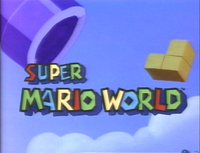
The third and last Super Mario cartoon by DIC Entertainment was based after this game, also titled Super Mario World. It aired from September 14, 1991, to December 7, 1991, and featured 13 episodes, the least number of episodes out of the Super Mario cartoons. While it has faithful elements to the original series, the cartoon has a focus on common prehistoric stereotypes and themes such as the Super Mario characters living with cavepeople and relying on anachronistic themes to introduce to the cavepeople such as cars, television, and telephones.
Super Mario World: Mario to Yoshi no Bōken Land[edit]
An interactive animated short film published by Bandai in 1991, Super Mario World: Mario to Yoshi no Bōken Land, is directly inspired by the game and explores all of the game areas. Through the Terebikko controller, the viewer would have been able to interact in the story.
Comics and manga[edit]
Nintendo Kōshiki Guidebook Super Mario World[edit]
The official guidebook by Shogakukan, Nintendo Kōshiki Guidebook Super Mario World, includes a short comic that narrates the prologue of the game: while enjoying a beach vacation in Dinosaur Land, Peach is taken away by a monster. While looking for her, the Mario Bros. come across Yoshi's egg, free him, and join forces to stop Bowser. Despite the book being in Japanese, the comic section is in English, with a translation written beside the panels.
Super Mario Adventures[edit]
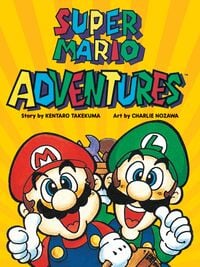
The Nintendo Power comic series based on SNES games includes one based on the game, Super Mario Adventures, serialized monthly in 1992. Chasing Bowser in Dinosaur Land, Mario, Luigi, Peach, and Toad encounter Yoshi, and, after being devided, they attempt to rescue one another from the Koopalings, until Bowser takes Peach away to marry her. After dealing with a Haunted House, Mario, Luigi, and Yoshi interrupt the ceremony and defeat the villain. Peach displays a more combative personality in the comics instead of being the usual damsel in distress.
The full comic (as well as Mario vs. Wario) was also reprinted in 2016.
4koma Manga Ōkoku[edit]
The Japanese manga series 4koma Manga Ōkoku has a series called Super Mario, in which its seven entries have stories and gags based on Super Mario World.
Super Mario 4koma Manga Theater[edit]
The Super Mario 4koma Manga Theater is another Japanese 4koma series that features many 4-panel visual gags based on Super Mario World. For example, one comic has Mario running out of time just as he was about to face Iggy Koopa, as Iggy dives into Mario, with the resulting momentum causing him to fall into the lava.
Super Mario Kodansha manga[edit]
Super Mario World is adapted in the first four entries of the Super Mario Bros. 4: Super Mario World miniseries in the Super Mario Kodansha manga by Kazuki Motoyama. The adapted volumes follow two storylines, originally published in different Kodansha magazines: the first one is the main adaptation, with Mario, Luigi, and Yoshi teaming up to save Peach from Bowser's clutches; and the second storyline showcases the three heroes, accompanied by Princess Peach, as they journey through Dinosaur Land, uncovering secret levels and shortcuts along the way. While starting as a more illustrative strategy guide, this latter storyline takes a more gag approach with skits parodying folkore or celebrities.
Five more entries follow, all taking place after the events of the game, and two of which never made into a volume. The first one sees the heroes trying to enjoy the vacation that was interrupted at the beginning of the story in Dinosaur Land. The others all take place back to the Mushroom Kingdom: a police detective arc in volume 6, a superheroes arc directly inspired by Ultraman: Towards the Future in volume 7, an Olympic event between all the kingdoms in the Super Mario world in volume 8, and lastly a time traveling story featuring a Dr. Mario lookalike in volume 9.
Two more spin-off entries in the miniseries, titled Super Mario World!, are adaptations of NES Open Tournament Golf and Yoshi.
Super Mario-kun[edit]
Super Mario-kun's first six volumes are all based on Super Mario World, making it the game with the most arcs associated with it. While the first four volumes follow a straightforward storyline, with each arc having the characters travel through the game's locations, volume 5 and the first half of volume 6 are interquels set between volume 3 and 4, immediately followed by the Super Mario Bros. 2 arc in volume 8. The second half of volume 6 is an afterstory, in which Peach is kidnapped again and taken to the Special Zone. The arc heavily includes elements from Super Mario Bros. 3, Yoshi, Super Mario Kart, and The Legend of Zelda: A Link to the Past.
Four of the chapters of this arc are included in the first part of Super Mario-kun Special Selection.
Gallery[edit]
- For this subject's image gallery, see Gallery:Super Mario World.
Caped Mario and Yoshi
Names in other languages[edit]
| Language | Name | Meaning | Notes |
|---|---|---|---|
| Japanese | スーパーマリオワールド[50] Sūpā Mario Wārudo |
Super Mario World (subtitled "Super Mario Bros. 4" on the logo) | |
| Chinese (simplified) | 超级马力欧世界[51] Chāojí Mǎlì'ōu Shìjiè |
Super Mario World | |
| Chinese (traditional) | 超級瑪利歐世界[?] Chāojí Mǎlì'ōu Shìjiè |
Super Mario World | |
| Korean | 슈퍼 마리오 월드[52] Syupeo Mario Weoldeu |
Super Mario World |
Give the world a whole new look![edit]
| Language | Name | Meaning | Notes |
|---|---|---|---|
| Japanese | スーパーマリオワールド 気分一新! イメチェンバージョン[?] Sūpā Mario Wārudo Kibun isshin! Imechen Bājon |
Super Mario World Complete Mood Change! Makeover Version | |
| Chinese (simplified) | 超级马力欧世界: 焕然一新! 感 觉大不同的版本[?] Chāojí Mǎlì'ōu Shìjiè: Huànrányīxīn! Gǎn jué dà bùtóng de bǎnběn |
Super Mario World: Completely renewed! A version that feels very different | |
| Chinese (traditional) | 超級瑪利歐世界: 別有不同的形象改變版本[?] Chāojí Mǎlì'ōu Shìjiè: Bié yǒu bùtóng de xíngxiàng gǎibiàn bǎnběn |
Super Mario World: A different version with a changed appearance | |
| Dutch | Super Mario World: Geef de wereld een nieuw uiterlijk![?] | Super Mario World: Give the world a new appearance! | |
| French | Super Mario World: Donnez de nouvelles couleurs au monde![?] | Super Mario World: Give new colors to the world! | |
| German | Super Mario World: Wie sieht es denn hier plötzlich aus?[?] | Super Mario World: What is it like here all of a sudden? | |
| Italian | Super Mario World: Il gioco ha un nuovo look![?] | Super Mario World: The game has a new look! | |
| Korean | 슈퍼 마리오 월드: 월드 전체를 완전히 새롭게 바꾸자![?] Syupeo Mario Weoldeu: Woldeu jeoncheleul wanjeonhi saelobge bakkuja! |
Super Mario World: Let's completely change the whole world! | |
| Portuguese | Super Mario World: Um mundo de aparência diferente![?] | Super Mario World: A world with a different look! | |
| Russian | Super Mario World: Пусть мир выглядит совсем по-другому![?] Super Mario World: Pust' mir vyglyadit sovsem po-drugomu! |
Super Mario World: Let the world look completely different! | |
| Spanish | Super Mario World: ¡Un mundo de apariencia diferente![?] | Super Mario World: a different-looking world! |
References[edit]
- ^ November 23, 1990. スーパーマリオワールド [スーパーファミコン]. ASCII Corporation. Page 10. Retrieved December 10, 2024.
- ^ Dentifritz. Super Mario World (KR). Scanlines16.com (French). Retrieved June 6, 2024. (Archived June 6, 2024, 20:12:24 UTC via archive.today.)
- ^ "A host of hot games is lined up and waiting, even before the Super NES arrives in the U.S. Several titles will be released as soon as the system becomes available, and many more will be released shortly after." – August 1991. Nintendo Power Volume 27. Nintendo of America (American English). Page 72.
- ^ Super Mario World (SNES). The Mushroom Kingdom (English). Retrieved June 27, 2024.[better source needed]
- ^ August 30, 1993. Nintendo chega hoje ao mercado. O Estado de S. Paulo (Brazilian Portuguese). Retrieved January 18, 2025.
- ^ Arcade flyer. Arcade Museum (English). Retrieved June 27, 2024.
- ^ https://www.nintendo.com/en-za/Games/Super-Nintendo/Super-Mario-World-752133.html
- ^ Nintendo of America (September 4, 2019). Nintendo Direct 9.4.2019 (23:06). YouTube (American English). Retrieved September 4, 2019.
- ^ Nintendo (September 4, 2019). Nintendo Direct 2019.9.5. YouTube (Japanese). Retrieved September 4, 2019.[dead link]
- ^ Nintendo of Europe. Exclusively for members, these 20 classic #SuperNES games can be played from 06/09 with Super Nintendo Entertainment System – #NintendoSwitchOnline! Members can enjoy select games with local or online multiplayer, and more games will be added soon! #NintendoDirect. Twitter (British English). Retrieved June 27, 2024.
- ^ Exclusively for members, these 20 classic #SuperNES games can be played from 6/9 with Super Nintendo Entertainment System – #NintendoSwitchOnline! Members can enjoy select games with local or online multiplayer, and more games will be added soon! #NintendoDirect. Twitter (Australian English). Retrieved September 4, 2019.
- ^ @NintendoAmerica (March 30, 2022). "Three classic #SuperNES and #NES titles are now live for #NintendoSwitchOnline members! ☑️ DIG DUG II ☑️ MAPPY-LAND ☑️ Earthworm Jim 2". X. Retrieved July 4, 2024.
- ^ @NE_Brian (March 31, 2022). Nintendo Switch Online adds SP versions for Super Mario World, Super Punch-Out!! Nintendo Everything. Retrieved April 1, 2022.
- ^ Nintendo 公式チャンネル (March 31, 2022). ファミリーコンピュータ & スーパーファミコン Nintendo Switch Online 追加タイトル [2022年3月31日]. YouTube. Retrieved July 4, 2024.
- ^ Sakai, Kazuya (Ambit), kikai, Akinori Sao, Junko Fukuda, Kunio Takayama, and Ko Nakahara (Shogakukan), editors (2015). 『スーパーマリオブラザーズ百科: 任天堂公式ガイドブック』. Tokyo: Shogakukan (Japanese). ISBN 978-4-09-106569-8. Page 11–13.
- ^ Nintendo Co., Ltd. HISTORY → Series → Super Mario. Mario Portal. Retrieved 6 Nov. 2024. (Archived October 3, 2024, 11:52:39 UTC via Wayback Machine.)
- ^ Sheff, David (1993). Game Over: How Nintendo Zapped an American Industry, Captured Your Dollars, and Enslaved Your Children (first edition). New York: Random House. ISBN 0-679-40469-4. Page 361.
- ^ September 1991. Nintendo Power Volume 28. Nintendo of America (American English). Page 18.
- ^ August 1991. Mario Mania Nintendo Player's Guide. Nintendo of America (American English). Page 43.
- ^ 1992. Super NES Nintendo Player's Guide. Nintendo of America (American English). Page 13 and 15.
- ^ Sakai, Kazuya (Ambit), kikai, Akinori Sao, Junko Fukuda, Kunio Takayama, and Ko Nakahara (Shogakukan), editors (2015). "Super Mario World" in『スーパーマリオブラザーズ百科: 任天堂公式ガイドブック』. Tokyo: Shogakukan (Japanese). ISBN 4-091065-69-4. Page 54–56.
- ^ Nintendo Co., Ltd. (circa 2021). Super Mario World. Mario Portal. Retrieved 17 Feb. 2025.
- ^ Kagawa, Ryo (APE/Shigesato Itoi), Koichi Toda (100 Percent), Masaki Kuramochi (100 Percent), Shigeo Tanabe, Naomaru Asao, and Ryuji Osawa, editors (1991). "UNIT 2 CHARACTER" in『任天堂公式ガイドブック スーパーマリオワールド』. Tokyo: Shogakukan (Japanese). ISBN 4-09-104117-5. Page 27–31.
- ^ Sather, Pam, Scott Pelland, George Sinfield, Leslie Swan, and Dan Owsen, editors (1991). "Foes" in Nintendo Mario Mania Player's Guide. Redmond: Nintendo of America (English). Page 50–52.
- ^ Roberts, Rachel, Cardner Clark, editors (2018). "Super Mario World" in Super Mario Bros. Encyclopedia: The Official Guide to the First 30 Years (First English Edition). Milwaukie: Dark Horse Books (English). ISBN 978-1-50670-897-3. Page 69.
- ^ a b c Iwata Asks: Music Commentary by Koji Kondo. Nintendo UK (British English). Retrieved June 27, 2024.
- ^ Thomas Game Docs (June 15, 2021). The pop song that Nintendo copied. YouTube (English). Retrieved July 1, 2021.
- ^ Kawasaki, Hondai (January 1991). "1990 Developer Interview" - Nintendo Official Guidebook for Super Mario World: Super Mario Bros. 4. Tokyo: Shogakkan (Japanese). Page 167.
- ^ NEWER VGM Sound Sources. Google Sheets (English). Retrieved June 27, 2024.
- ^ a b c d TCRF. Super Mario World (SNES)/Version Differences. The Cutting Room Floor (English). Retrieved June 27, 2024.
- ^ Takashi Tezuka, Shigefumi Hino and Hisashi Nogami. Super Mario World and Super Mario World 2: Yoshi's Island. Nintendo of America (American English). Archived October 3, 2017, 01:44:26 UTC from the original via Wayback Machine. Retrieved September 19, 2020.
- ^ August 1991. Mario Mania Player's Guide. Nintendo of America (American English). Page 32.
- ^ Grooveraider (February 6, 2008). Super Nintendo: Parents not gonna like what they hear.... YouTube (American English). Retrieved June 27, 2024.
- ^ Grooveraider (August 10, 2011). Parents Upset Over New Nintendo Console - Super Nintendo - Circa 1991. YouTube (English). Retrieved June 27, 2024.
- ^ Mitchell, Richard (November 9, 2010). This is Shigeru Miyamoto's Favorite Super Mario Game. Engadget (English). Retrieved June 27, 2024.
- ^ https://themushroomkingdom.net/bugs/107
- ^ Mandelin, Clyde (November 21, 2013). The 4 Japanese Names for Super Mario World’s 8 “Special” Courses. Legends of Localization (English). Retrieved June 27, 2024.
- ^ As explained by Dayvv Brooks, formerly credited as "Dayv Brooks", on July 18, 2012.
- ^ Super Mario World. Metacritic (English). Retrieved September 19, 2020.
- ^ Navarro, Alex (February 6, 2007). Super Mario World Review. GameSpot (English). Retrieved September 19, 2020.
- ^ Thomas, Lucas M. (February 5, 2007). Super Mario World VC Review. IGN (English). Retrieved September 19, 2020.
- ^ O' Neill, Jamie (September 21, 2019). Super Mario World Review. Nintendo Life (English). Retrieved September 19, 2020.
- ^ Whitehead, Dan (June 9, 2007). Virtual Console Roundup. Eurogamer. Page 2. Retrieved September 19, 2020.
- ^ September 1997. Nintendo Power Volume 100. Nintendo of America (American English). Page 90.
- ^ Edge Staff (June 25, 2007). THE NINTENDO YEARS. Edge.com (English). Archived May 23, 2012, 19:22:23 UTC from the original via Wayback Machine. Retrieved September 19, 2020.
- ^ Cabbusses's Retro Obscurities (August 3, 2019). [IRL] スーパーマリオツインクッカー | Using the Super Mario Twin Cooker (DISCORD REQUEST). YouTube (Japanese). Retrieved June 27, 2024.
- ^ July 28, 2003. Super Mario Ice Cream?. X-Entertainment. Retrieved June 27, 2024.[dead link]
- ^ smbcollector (September 24, 2009). Super Mario Bros Cookie Boxes. YouTube (English). Retrieved June 27, 2024.
- ^ Sly DC (November 19, 2015). Nelsonic Super Mario World Game Watch. YouTube (English). Retrieved June 27, 2024.
- ^ Japanese boxart
- ^ From the official translated name in Super Mario Maker 2
- ^ Korean boxart
External links[edit]
- Super Mario World
- Games
- Super Famicom games
- Super Nintendo Entertainment System games
- Nintendo Power games
- Arcade games
- Virtual Console games
- Wii Virtual Console games
- Wii U Virtual Console games
- New Nintendo 3DS Virtual Console games
- Nintendo Switch Online games
- Platforming games
- 1990 games
- 1991 games
- 1992 games
- 1993 games
- Launch titles
- Nintendo Classics
- Player's Choice
- Amiibo tap: Nintendo's Greatest Bits
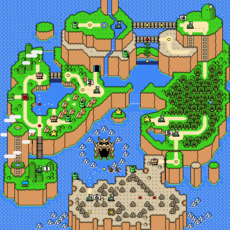
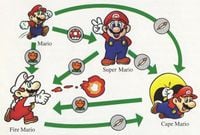
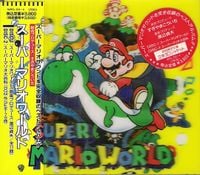
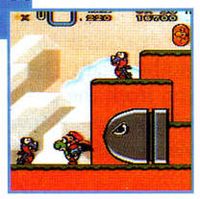
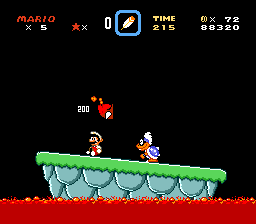
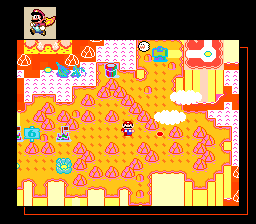
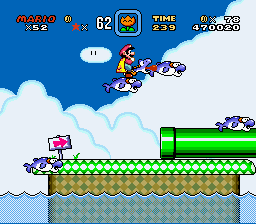
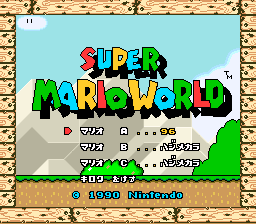
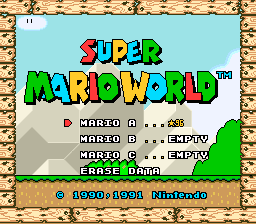
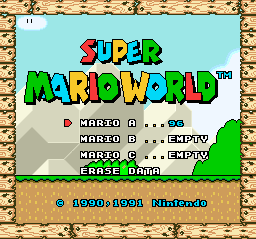
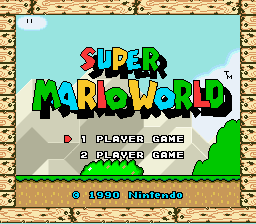
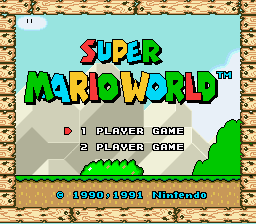






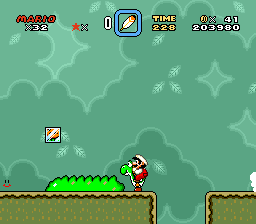
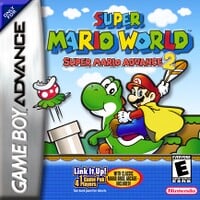




![The Super Mario Twin Cooker, a cooking item for household kitchens.[46]](https://mario.wiki.gallery/images/thumb/9/9a/Super_Mario_World_Twin_Cooker.jpg/120px-Super_Mario_World_Twin_Cooker.jpg)
![Promotional ice cream that came out after the release of Super Mario World. The ice cream itself is in the shape of Mario's face with a green bubble gum nose.[47]](https://mario.wiki.gallery/images/thumb/7/7c/Super_Mario_Bros._Ice_Cream_Bar.jpg/120px-Super_Mario_Bros._Ice_Cream_Bar.jpg)

![An assortment of Mario chocolate- (left), honey- (middle), and cinnamon- (right) flavored cookies manufactured by Sunshine Biscuits. The characters featured are from Super Mario World.[48]](https://mario.wiki.gallery/images/thumb/4/4b/Cookies.jpg/120px-Cookies.jpg)
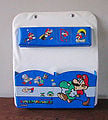


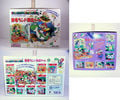
![Super Mario World, a Nelsonic Game Watch that was a highly simplified version of Super Mario World. Compared to the original, it had shorter levels, simplified gameplay, and inferior graphics.[49]](https://mario.wiki.gallery/images/thumb/a/a1/SMWWatch.jpg/96px-SMWWatch.jpg)

